

How To Start A Travel Fund (And Why You Need One Right Now) – Episode 2

You have dreams of traveling the world. Whether you hope to quit your job and become a digital nomad or plan a family vacation to DisneyWorld (or Universal), at some point, the cost will cross your mind. If you’re wondering how to fund travel, you are not alone. I’ve devoted this entire website and podcast, The Thought Card , to answering this important question. Having the chance to visit 27 countries, I’ve mastered starting a travel fund and budget for travel. I believe in not letting our financial responsibilities keep us from pursuing our dreams.
While travel doesn’t have to be expensive, it does cost money. Although you no longer have to be wealthy to jet-set across the globe, I can imagine it certainly helps. Nevertheless, it’s possible to travel even if you’re on a budget.
If you want to travel more, I recommend creating a travel savings account first . Let’s walk through step-by-step how to start a travel fund and ways to save regularly .
Continue reading or listen to the episode here:
Listen on Apple Podcasts | Spotify | Pandora | Amazon Music
In this episode, we cover:
- What is a travel fund?
- How to start a vacation fund
- How to save for travel by treating it like a recurring bill
- Best saving accounts for vacations
- What is a Travel Fund?
Table of Contents
1. Keeps funds separate
2. avoids overspending, 3. keeps you grounded, 1. treat travel like a recurring bill, 2. start small, 3. leverage automation, ways to boost travel savings, how to save for vacations: my personal story.
A travel fund is a powerful tool you can use to help you save money for travel.
A “travel fund” or “vacation fund” is a dedicated bank account (checking, savings, or money market) devoted to your travel savings and expenses.
It helps you intentionally save money for travel, so when it comes time to spend, you have a stash to pull from.
Reasons To Start a Travel Fund
The more you commingle funds, the less likely you are to achieve your goals – both long-term and short-term money goals . Even with the best intentions, spending money on other things is easy if your funds are jumbled together.
Having a bank account specifically for travel makes things so much easier. You can check your balance at a glance and know exactly how much you can spend. Isn’t that reassuring?
Have money available for travel when you need it.
In many ways, it gives you permission to spend on what you want.
Helpful Tip: Pay for travel expenses with your travel fund and only spend what you have.
My Mindset : Although I love to travel, travel isn’t worth getting into debt. Debt is a vicious cycle that is hard to get out of, so save money for a trip and travel when you can responsibly cover all of your expenses.
With that said, here are (3) ways a travel fund can help you travel more.
When you commingle funds, you are less likely to achieve your goals.
This is why I have multiple bank accounts — a virtual envelope system where each account is set up for a specific purpose, a bill, or a goal.
A travel fund is important because it’s so much easier to save money for travel when it has its own dedicated savings account separate from everything else. So, when you have to pay for a flight or want to go on a spontaneous weekend getaway, you can tap into the funds you set aside specifically for travel expenses, like flights, lodging, attractions, and more.
Helpful Tip : I recommend personalizing the name of this account by renaming it “Cruise to Mexico” or “Disney Family Vacation.” This makes your next adventure feel a little more real.

Travel savings can also help you avoid getting into debt and paying high credit card fees. To avoid the temptation of using my travel savings on other expenses, I bank with Ally Bank, an online bank. While Ally is easy to use, it takes a few days to withdraw funds, making it less convenient than an ATM withdrawal from my brick-and-mortar bank. This slight inconvenience helps me avoid the temptation to dip into this account, which strengthens discipline.
I’ve found that having a travel fund brings clarity to my finances. It helps keep my wanderlust in check (because it can be hard to resist flight deals ).
Related: How Cheap Flight Alerts Work
For example, today, I have $500 in my vacation fund. Let’s book those flights to San Francisco for $220. On the other hand, I’m not quite ready for that all-inclusive trip to Costa Rica for $2,000.
Overall, a vacation fund makes travel more financially feasible. Know with certainty what you can afford.
How To Build a Travel Fund
Instead of saving for one trip, save for travel regularly, even if you don’t have upcoming trips planned.
Treat travel like any other recurring bill.
Include it as a line item in your monthly budget, making it a regular part of your financial planning. This will make travel a structured and intentional part of your life, enabling you to achieve your travel goals while managing other financial responsibilities.
Consider travel as essential as your car insurance, rent, and gym membership.
Like a recurring bill, you’ll set money aside for it every month without fail, which builds consistency.
If you treat travel like a recurring bill, you can save hundreds or thousands of dollars by the end of the year. It all depends on how aggressively you save.
Next, determine how much you want to save towards travel every pay period (weekly, biweekly, or monthly).
Start with an amount you can afford to miss as you build the discipline and confidence to increase your savings rate.
Small amounts can add up over time. Consider saving a little each week or month, such as the cost of a coffee or lunch, and watch how it accumulates.
You can set up direct deposit with your employer and choose the amount you want to transfer. This way, money from your paycheck will get deposited into your travel bank account every time you get paid. This way, your savings grow in the background without requiring constant attention. Go about your life – set it, forget it, and watch your travel savings grow!
Automation handles all the heavy lifting, so you never have to worry about moving money into your travel fund. It’s done automatically on your behalf. You’re essentially locking yourself in and sticking to your plans.
Helpful Tip: Don’t wait for the day or even the week after to move funds because you might forget. Automate your finances so that when you get paid, a portion of your check is saved automatically for your next vacation.
Related: How To Keep Your Vacation Fund Intact
Listen on Apple Podcasts | Spotify | Amazon Music | Pandora | YouTube | Any player
If you want to schedule additional automatic transfers to accelerate reaching your travel savings goals, by all means, do so.
Set regular automatic transfers into your travel fund weekly, biweekly, or monthly. Pick a transfer frequency and amount that works for you.
These additional deposits can be as small as $5 or as large as you can possibly afford. The rationale here is that these additional payments will boost your savings rate over time and help you reach your travel goals faster.
Savings challenges like the 52-Week Savings Challenge or $5 Bill Challenge can help you set aside extra cash.
With the 52-Week Saving Challenge in week 1, you save $1. In week 20, you save $20 until you save $52 in week 52. By the end of the challenge, you save $1,378.
The Reverse 52-Week Challenge is the reverse of the 52-Week Challenge. With the Reverse 52-Week Saving Challenge, you save $52 in the first week, $20 by week 20, and $1 in week 52.
Savings challenges make saving money more fun, and at the end of the challenge, you’ll have a stash of cash waiting for you at the finish line.
A travel fund money box put in a visible place in your home or office may be another fun option to save your loose change.
Here are some of my favorites from Amazon:
- Travel Fund – Piggy Bank
- Shadow Money Box For Saving Travel
- Adventure Fund Piggy Bank
Tired of reading? Listen to this podcast episode on Spotify.
It all starts with your mindset. How important is travel to you?
When I first started thinking about setting financial goals for travel, it all began during my college years. I was experiencing a serious case of FOMO—fear of missing out—while watching my friends jet off to exciting destinations for spring break. While I had enough finances to enjoy local outings, I couldn’t afford an international trip.
The pivotal moment came when I wanted to study abroad in France for a semester. The cost was astronomical, and none of my scholarships or grants covered it.
My family was facing financial difficulties at that time, and I felt guilty even considering such an extravagant trip. This experience made me realize how crucial finance is in pursuing my travel dreams. I didn’t want to feel helpless or uncertain about when I could travel again.
After graduating, I committed to prioritizing travel in my life. I understood that I needed to be strategic and smart about my finances .
I reframed my relationship with money, viewing it not as a burden but an opportunity to create experiences. I became a goal-getter, setting clear short-term financial goals aligned with my passion for travel.
I learned that saving for travel doesn’t have to be overwhelming. It starts with small, actionable steps. I began by creating a budget that included a dedicated travel fund. I automated my savings, setting aside a portion of my paycheck specifically for travel. This way, I could watch my travel fund grow without thinking about it.
Ultimately, my journey taught me that travel is not just a luxury; it’s a priority that can be achieved with careful planning and a positive mindset. By setting financial goals for travel, I transformed my dreams into reality, allowing me to explore 27 countries across four continents. If I can do it, so can you!
Do you have a travel fund? Why or why not?
Read the full transcript to the podcast episode below.
Danielle Desir Corbett: Welcome to The Thought Card, a podcast about traveling money where planning saving and creativity leads to affording travel building wealth and paying off debt. We are the financially savvy travelers. Hi everyone and welcome to episode two of the Thought Card podcast. Today, we're going to talk about the importance of having a travel fund and really how to get it started. So I'm going to take you back five years or so ago. It's been a little while, but after I graduated from grad school, I threw a nice shindig with my family to celebrate my victory. Right? And from that dinner I had, let's say about $700 in gifts. So for me at the time I hadn't traveled Because I didn't have any money, I didn't have a job really. So I put that $700 gift money into a separate account and I call that my travel fund and that's really where it all started for me and I can honestly credit my travel fund for allowing me to financially be able to travel because honestly having all my money in one-account doesn't work for me. I have a number of make accounts and we can talk about that in another episode. But really I found that a travel fund is a powerful tool that I used to help me save money for travel and honestly travel doesn't have to be expensive, but it does cost money no matter what anyone says. Travel cost money. I recently read an article from stuff dot com where a travel influencer had spent $170 on accommodation, travel The world in 12 months and that's amazing. She spent less than $200, but guess what she spent money. So regardless of what kind of travel style or what you do when you're traveling, you're going to spend some type of money. So I found that the easiest way for you to make travel financial priority in your life and the first thing I recommend to people is to start a travel fund. So what is a travel fund? A travel fund is simply a separate bank account dedicated to your travel savings and expenses. Okay, It can be a checking account, a savings account or a money market. The only caveat is if you put your travel fund money in a savings account in the United States, you are limited to six transactions per month before incurring a fee. So I recommend keeping your money into a checking account or a money market. That really makes things easier. You don't have to worry about fees, which is great. A travel fund is important because it helps you be intentional with your money by separating it out. Like I said, if you're someone like me who has really hard time with jumbling all their money together. Travel fund is great because it separates it out and when you're saving for travel, it's helping you be intentional, so when the time comes that you want to book those flights to hawaii for your honeymoon or go on a road trip with your girlfriends, you have a stash to pull from. You don't have to scratch your head like where is this money coming from? I really want to have this experience with my family and friends. You have a stash to pull from, no questions asked because hey, you've been doing the work you've been saving for it right. The point of having a travel fund is to have the money for travel available when you need it on demand. Right, Alright, Danielle. So I already have a checking account. I already got my numbers all set up. Why do I need to keep my travel fund separate? Well, it's really simple because the more you commingle your funds together, the less likely you're able to achieve your goals because in your mind, you're not distinguishing what money is what and you have to keep track of all of these numbers together and all the things that you want to do with these funds. So even with the best intentions, it's easy to spend money on other things if all of your funds are jumbled together. So that is my case for having a travel fund. A travel fund makes things so much easier because at the end of the day, you can take a look at your balance and know exactly how much you have available to spend on travel. Isn't that reassuring? So your travel fund will let you know if you can book right now or if you'll need a little bit more time to build your savings. Let's look at my travel fund right now. My travel fund actually has $245 in it right now. So I'm totally down with booking those flights in San Francisco in October because those flights are 220 and I got $24 left to spend. So that is the beauty of having a travel fund is that you can look at your bank account and know how much you have to spend. And with the travel fund you can be that exact, it helps you to avoid getting into debt paying high balances on credit cards and getting into a bunch of mess. I found that having a travel fund brings a lot of clarity into my finances and it also helps keep my wanderlust in check because it is so hard for me to resist a flight deal Guys, it is literally impossible. I love cheap flights. I love flight deals and having a travel fund really does keep me in check because if I don't have it, I don't got it. I'm not really going to book those flights. So if travel is important to you, consider consider having a travel fund and number two, consider treating it like a recurring bill. Okay, this can be groundbreaking because I treat travel like a recurring bill because it is so important to me and I set money aside for it every single month. Travel is right up there with my mortgage, my car insurance, my car note and my netflix subscription, All those things I need every day, all those things are things that help me stay alive and live my lifestyle and so does travel, travel is super important, so I treat it like everything else And this is great because it helps me create consistent saving habits and if you treat travel like a recurring bill, you'll save hundreds if not thousands of dollars by the end of the year if you don't touch it. So for example at $50 a month, that's a total of $600 in your travel savings a year and at $100 a month as a total of $1,200 in travel savings a year. So if you start small, you really can see the momentum pick up with your travel fund and your travel savings now that you have a travel fund. I suggest that you have your employer direct deposit money into your travel bank account, don't wait for the day after or even the week after to make this transaction, do not delay, do it the day you get paid and if you're a freelancer and you're getting money for a bunch of different clients, build that in to your transactions. If you have a business bank account, transfer some money into your travel fund when you're doing your drawdown every month again, this is back to the idea of consistency. Travel fund savings for me is a lot about consistency and saving in general is about consistency. Direct depositing really helps this because it really makes things easy because it's automated, You never have to remember to add money. Oh did my employer do this? Oh did I get oh I do, I know you don't have to worry about it because you said it, you forget it and you just watch it grow, which I love personally, I would say to start off with an insignificant amount that doesn't take too much sacrifice out of your budget and then build your savings rate from there. So if you want to start with $25 a month, 50 70 500 and then grow and grow and grow gradually. That really, really helps. Okay, so now if you want to schedule automatic transfers after you get paid to accelerate your goals, by all means guys go for it. So I say for travel every pay period, but recently I've decided to take things up a notch a little bit by adding an automatic transfer every Tuesday. So I'm adding a little bit of maybe $25 here, $25 there just to kind of boost things and make things accelerate so that I can travel too far and further places. So where do I suggest parking your travel fund? Like I talked about a little bit before the top of the show I recommend either a checking account or a money market that doesn't incur fee, don't put your money in big accounts where your bank is going to charge you fees for it because guess what? That's eating into your margin, that's going to affect your travel down the line. So I have my travel fund at Ally Bank. I've been their customer for many years. I think I was one of their first customers. They first came out and they're an online bank with relatively high interest rates and they're awesome because they're so easy to use setting up an account is like a piece of cake. And honestly I think I have like 10 big accounts with them right now. So I can't recommend Ally Bank enough. And I know a lot of my listeners also use ally bank. So let's recap if you want to afford travel and you want to make it truly a financial priority in your life, Start a travel fund which is simply a separate bank account devoted solely to your travel savings and your expenses. Next treat your travel like a recurring bill right up there with your mortgage, your rent, your gym membership, anything that is recurring every month, treat it like a recurring bill and lastly have your employer directly deposit money into your travel fund so that you can set it and forget it and watch it grow. Okay, automation is a powerful, powerful, powerful tool because we have so much going on that sometimes we can't even think about like you know, things that we really want in our life, we really can't think about it. So automation just makes things so much easier out of sight out of mind, which I love. I'm going to sign off by saying that the concept of saving is simple guys, it's so simple, but it is not easy and whoever said it is is lying, but some simple planning with some type of planning, you'll really get the results, you want to go on that cruise plan that bay weekend getaway and go on the excursion with your family which you deserve. Okay, I encourage you to invest in you invest in your future, invest in your future travel experiences and start saving money in your travel fund today. I want to know if you have a travel fund, why or why not? Or maybe you didn't have a travel fund before and you're reconsidering it and you are going to start one now, let me know, I would love to hear from you, I would love to hear about your transformation if you have one or if you're going to stick to your guns and like, nope, I don't need to travel fund, I'm going to still do my own thing and the best discussions happen over on the website podcast dot dot card dot com and I would love to hear from you, thank you so much for tuning in and I cannot wait to see you in the next episode. Bye.
Daphne: Yes, I do have a travel fund and the reason being is because a couple years ago I set a goal that I wanted to travel to one new country a year, which meant that I had to save up to travel to that new country every single year. Over time I decided to create a bigger budget just because that I realized I could actually do more than that and travel to more countries per year while saving money while I'm at home.
Kyle: Um no, mainly because I'd say how much I get paid doesn't really allow it right now because you know, I have savings and emergency that I can't really just spread my money over everything. I still need some money in the bank for, you know, gas or whatever.

Danielle Desir Corbett paid off $63,000 of student loan debt in 4 years, bought a house at 27, and has traveled to 27 countries, including her favorites, Iceland, China, and Bermuda. Go here to learn Danielle’s incredible story, from struggling financially and in debt to finding creative ways to earn more and live on her terms. Listen to The Thought Card Podcast , where Danielle shares how you can creatively travel more and build wealth regardless of your current financial situation. Reach out to Danielle by contacting: thethoughtcard (at) gmail (dot) com.
You might also like

Hey girl! I finally listened to this one and loved it! I also just set up a high yield savings account with Capital One. They don’t have the highest rates out there, but I already am a loyal customer and credit card user and personally wanted to limit how many different banks I have accounts with. :)
So glad that you had a chance to listen. Capital One 360 is very popular so you can’t go wrong! What episode will you listen to next?
Leave a Reply
Leave a reply cancel reply.
Your email address will not be published. Required fields are marked *


What’s a Travel Grant, and How Do I Get One?

The ability to travel opens your eyes to worlds apart from your own. While this type of experience is invaluable, it does cost money — sometimes, a lot of money.
That’s where a travel grant comes in. This type of allowance provides the funds you need to get yourself around the world and back again.
What Is a Travel Grant?
In general, federal or state governments — as well as educational institutions — can provide you with a grant. As far as travel goes, though, they’re most often awarded by the latter.
Students who propose to travel to a far-flung destination should come to the awarding officer with a detailed proposal as to why this trip is essential. In most cases, they’ll have to show the type of research they’ll be able to conduct while they’re out of the country. If the university or organization providing the grant sees the value in the trip — say, it’s for research instead of relaxation — they will likely give a plan the go-ahead.
There’s a slight difference between travel grants and scholarships. To obtain the latter, one typically has to show proof of academic excellence or another exceptional talent. The money awarded often goes toward tuition fees incurred while studying abroad, which might make it harder to obtain a scholarship for research pursuits or cultural immersion.
How Do I Get One?

It may seem as though graduate and Ph.D. students are the only ones who can pursue travel grants that fund research, but that’s not always the case. In fact, there are a few organizations outside educational ones that will provide grants for travel — check with UNESCO and the UN, as well as the SPRET educational trust , which tends to choose students based in designated areas.
All these groups will fund trips aimed at personal or cultural development, not just educational growth. There might be other options, too — be sure to do your research for the best fit.
Every application for a grant will be different. In most cases, you’ll have to come up with some sort of proposal that outlines what you plan to do on your trip, as well as what you think you’ll gain. Do some research into the background of the organization you’re applying to, then cater your aims to mirror their mission and goals.
Some organizations will require an in-person interview or presentation of your proposal. From there, it’s just a waiting game to see whether you get the grant.
What Are My Other Options?

The grant isn’t the be all, end all of travel funding. In fact, there are multiple ways to see the world without breaking the bank , and some may fit your bill better than an educational or research grant.
For example, many people travel abroad to teach English as a second language. Countries like Spain and South Korea have programs that only require you to be a native speaker. You can then live, work and get paid abroad, which gives you an immersive cultural experience and the chance to travel with a sizable income.
Some charities allow you to volunteer abroad, while you can also take on odd jobs such as farming to see other pockets of the globe for free. In many cases, you’ll have to fund your flight, but your host will take care of the room and board, saving you big overall.
No matter how you make it happen, one thing is for sure: travel is one of life’s most rewarding experiences. If you want to learn more about the world — and yourself — a travel grant might be the way to do it.
About the Author:

Related Posts
Crowdfunding is a fantastic way to raise the money needed for travel, but there are other tried and true ways to save and earn the money you need. Budgeting for a trip can be daunting when you add up what you expect to spend on transport, food, and lodging. However, if you use these money saving and earning tips on your travels in conjunction with good budgeting skills, you’ll find that traveling the world does not have to be as costly as it might appear. Couch Surfing There are a surprising number of opportunities to find free lodging on your…
We know eating healthy, exercising regularly, and relieving stress is good for us. But did you know travel may be just as beneficial? Traveling is exciting and pushes us outside our comfort zones into new cultures and experiences. It is also said to enhance creativity, relieve stress, and boost mental health. Now imagine gaining all the many benefits of traveling while also making a positive impact on the world. Could you take your vacations and travel plans and use them to help save the planet? There are plenty of people already using travel as a gateway to helping animals and…
When you’re on a budget, it’s hard to get to do things you enjoy. You’re putting most of your money toward essential purchases like groceries, your gas tank and bills, and a budget means that after you pay for all of those things, you don’t have much money left. While people are going out to the movies and taking road trips, you’re back at home wishing that you could know when you’ll be able to do the same thing. Wish no more! It’s completely possible to travel while you’re on a budget. If you make some adjustments to save even…
Sometimes the most difficult part of the fundraising process is saying thank you. How do you do it? A song? A crocheted scarf? Maybe you’re not too fond of your singing-voice, but your crochet-skills are on-point. Maybe you like paint and want to create portraits of all your donors. Or maybe you simply want to say thanks in person over a nice dinner. There are numerous ways to thank donors, and the style is up to you! No matter what you think would work best, be sure to say thank you somehow. Sure, a donation is a no-strings-attached way to…
In today’s world, you can leave your work but your work won’t leave you. We have our work responsibilities and we are really busy. But sometimes we need to get out of our cubicles and wander off to beautiful places. But hey, when you finally decide to wander off, you are delegated an important assignment to complete, a meeting to attend, etc. Hence, the travel gets delayed or you end up having to work in the middle of your exciting trip. We all have become somewhat like ‘Road warriors’. While work is our necessity it’s not always easy to do…
For many people traveling abroad can be a dream trip. Most people want to explore the other side of the globe however, only a few make this dream true. Traveling to a foreign country can be an exciting thing to do. The world is full of places with both nature and man-made wonders. You might be wanting to visit the high fashioned life of Paris or the enchanting peaks of the Himalayas. Ultimately, your dream trip can be anywhere in the world. However, it takes a lot of planning and preparations for traveling abroad. If your dream city is in…
While scrolling through our Instagram & Facebook accounts, we come across an overwhelming number of inspirational quotes. Midst that downpour of posts, there are one or two quotations that capture our eyes and grip our hearts. Quotes that we personally relate to and quotes that drive us towards our purpose. We certainly save and like these and set them as social media ‘status’ or ‘stories’. Ever happened to you? We’re sure it has. For all the wander-lust hit people, here’s a roundup of 10 triggering quotes that inspire like magic. If you are a low budget traveler, you’ll relate to these even more….
Slowly but surely, travel is changing. The magic of the internet has transformed how we connect with other people and how we find funding for our adventures. It’s no longer a matter of knowing the right people or having independent wealth (though that never hurts). If you have a the will to travel and the chutzpah to pack up and take the leap, you merely have to get in front of the right people, and the funding will come. It’s easier said than done, though, right? With so many people campaigning for their own projects, how do you set…
Traveling on a low budget is tough, and it always requires a bit of thought. One of the best ways to save is to think about your destination carefully. While it does have to be a place that you want to visit, it also needs to be in line with your budget requirements. Here’s how to go about finding a place that will work. Check the latest deals Looking for cheap deals on flights and accommodation will get you off to a good start. At different times of year, different destinations might be more expensive than at other times, they…
“There are three things in the world that deserve no mercy, hypocrisy, fraud and tyranny.” – Frederick William Robertson You’re on vacation in a foreign country. You check in to the hotel, leave your luggage in your room, grab the most needful items and go sightseeing. There’s so much to investigate! Once you’re out, you notice a souvenir shop with cute backpacks. “I need to have one,” you think. In this very moment, you remind yourself you’ve only US dollars in your purse. “Right. I need to find a currency exchange.” You look around, notice at least three, and choose…
One of the advantages of freelancing is that you are not confined to your office. Instead of spending days in the office from 9 am to 5 pm, a freelancer works any time of the day and anywhere – in a café, in a park or at an airport in anticipation of a flight. You can record a webinar, conduct an advertising campaign, polish your website and all this can be done on the way to Paris or Bangkok. With today’s challenging economy, freelance and travel can be the best way to simultaneously enjoy life and make a living. The…
Your backpack is packed. Your budget is set. Your mom has told you repeatedly to remember to stay in touch. And you’re filled with nervous anticipation for your first solo trip! Maybe your friends were busy, completely broke, or simply not interested in traveling. Or maybe a solo adventure has always been something you’ve dreamed of and you finally worked up the courage to do it. Whatever the reason, you’re about to take off on what is bound to be a life-changing adventure! If you’ve never traveled solo before, here are a few things I wish I’d known before I…
Traveling the world is a bullet on everyone’s bucket list. Many people work hard and earn money only to fulfill their eternal dream to see the whole world before they bid an adieu. This is because traveling is so much fun. But, things instantly change and the fun rises to manifolds when someone else puts their money on the table to fulfill your dream. Well, this might sound unreal, but it is not a novel thing. We of course are talking about crowdfunding. Crowdfunding is the tool that has helped many cover the tortuous path that leads them to their…
Travel provides the perfect opportunity to check out new places and cultures. It expands your mind, and the memories you create will stay with you the rest of your life. The challenge is finding the time to travel, especially if you lead a busy life or don’t have much disposable income to put towards trips. But with the right strategy, those excuses will be a thing of the past. Here are five great ways to start traveling more often. Set up Travel Alerts If you’re open regarding where you travel, then you should definitely set up alerts from a few…
We were lucky enough to be able to interview one of our most successful campaigners, Amy Abrigo. Amy isn’t only successful because she reached her FundMyTravel goal once, she has actually created and reached her goal for 3 different campaigns using the FundMyTravel platform! Her 4th campaign has only been live for a month and is already 82% funded, which you can view and donate to Fly Amy to the Abbey Theatre in Ireland. Amy caught our eye because of her story, the great campaigns she has ran, and her motivation to reach her goal. Read her interview below and…
Leave a comment Cancel reply
Save my name, email, and website in this browser for the next time I comment.

How to Start a Travel Fund and Save Money For Your Next Trip
As a travel enthusiast, you are no stranger to the allure of exploring new destinations, immersing yourself in diverse landscapes, and creating unforgettable memories. However, turning those dreams into reality often requires careful financial planning. Fortunately, with the right strategy, you can save money for your next adventure. In this guide, we’ll provide great tips on how to start a travel fund and make your dreams come true without breaking the bank.
Table of Contents
When planning a trip, you need to have a budget. Whether you are planning a trip yourself or engaging with a travel consultant to plan a trip for you, it’s always a good idea to set up a travel fund. I have been doing this for years and it’s allowed me to travel where I want to without going into debt to do so!
Disclaimer: This post may include affiliate links. If you click one of them, I may receive a small commission at no extra cost to you.
How to Start a Travel Fund
Set clear travel goals.
The first and most crucial step in saving for a travel fund is setting clear travel goals. Determine where you want to go, what experiences you want to have, and how much you’ll need for your trip. Creating specific, measurable, and achievable goals will give you a clear target to work toward.
When I decided to take a trip to South Africa, I had to start planning my trip so that I had an idea of how much money I needed to save to take the trip and do the things I wanted to do.

How To Set Up A Travel Fund: Dedicated Travel Account
Open a separate savings account specifically for your travel fund. This will help you keep your travel savings separate from your regular expenses and avoid the temptation to dip into the travel fund for other purposes. Consider setting up automatic transfers from your primary account to ensure consistent savings. There are many banks where you can set up online accounts so that you cannot access the money easily.
A couple of great options is Sofi Bank in the USA or Simplii in Canada. These companies usually offer deals that if you set up automatic deposits over a period of time, then you get a bonus of extra money. It’s a great way to get some additional cash to grow your travel fund.

How to Save For Travel Fund: Budget Wisely
To save money effectively, it’s essential to create a realistic budget. Track your monthly income and expenses to identify areas where you can cut back and redirect funds to your travel fund. There are many free budgeting apps available, but honestly I have been using a good old Excel spreadsheet for years.
I track my income, fixed expenses (rent or mortgage, insurance, fees), variable expenses (internet, tv, cellphone, utilities) and other spending (gas, groceries, dining out, spending money). There are a lot more categories but hopefully you get the jist of it. I figure out what I have that is extra that I can put into that separate account.

Save Strategically to Grow Your Travel Fund
Look for creative ways to save money for travel and boost your travel fund. Also consider setting aside extra money when you start a travel fund. Things like:
- tax refunds
- picking up overtime (if your job allows that)
- monetary gifts
Some bank accounts allow you the opportunity to round up purchases to the dollar. Say you use your debit card for a purchase of $10.30. $0.70 can be redirected into another account. You may not notice that extra money going into a travel fund, but it can add up.
Also look at if your credit card offers a cash back option. My credit card has a 2% cash back option on certain categories of spending. When I spend on restaurants, groceries or gas using my credit card, then 2% is deposited into a bank account monthly. This is a perk of the bank I am with. Just make sure if you use a credit card, you pay it off every month and don’t incur extra debt.
How to Save For Travel Fund: Earn Extra Money
There really are many creative ways to save money for travel. Explore opportunities to earn extra income through part-time work, freelancing, or selling unused items.
Embrace Frugal Living
Making small sacrifices in daily spending can add up quickly into your travel fund. Cutting unnecessary expenses can significantly impact your travel fund. Evaluate your spending habits and identify areas where you can trim costs. This may include dining out less, canceling unused subscriptions, or finding more affordable alternatives for everyday purchases.
A great tip is to find coupons and deals that will save you money at the grocery store or to drive less to save on gas.
Travel Smart
While saving for travel fund is essential, there are also ways to reduce travel expenses without compromising the quality of your trip. Look for budget-friendly accommodations, use travel rewards programs, and plan your trips during off-peak seasons to secure better deals on flights and accommodations.

Stay Committed to Saving For A Travel Fund
Regularly monitor the progress of your travel fund. Adjust your savings strategy if needed and stay motivated by tracking your progress toward your travel goals. Celebrate milestones along the way to keep your enthusiasm high.
Starting a travel fund takes time and dedication. It’s essential to stay committed to your goals, even when faced with tempting alternatives. Remind yourself of the incredible experiences and adventures that await you once you reach your savings target.
Free Resource: Trip Planning Checklist
As you start to save for your trip and build a travel fund, you may want to start planning your trip. This free checklist outlines the steps for planning your vacation.
Download it here to get started.

Starting a travel fund and save money for your next trip is an achievable goal with careful planning and commitment. By setting clear goals, creating a dedicated fund, budgeting wisely, and adopting a frugal lifestyle, you’ll be well on your way to exploring new destinations and making your travel dreams a reality.
So, if you are wondering how to start a travel fund today, follow these tips above and embark on the trips you deserve for your hard efforts.
If you enjoyed my post, follow me on social media or subscribe to my newsletter below, so you can stay connected on future posts, trips, tips and more.
Melanie is the founder of The World Travel Girl. She has been traveling for over 12 years and decided to share her passion with others. She is a travel writer and travel planner who also loves hiking, birdwatching and watching wildlife. Her mission is to help every day people explore the outdoor world and connect with nature.
Great tips! Love your blog!
These are some really helpful tips. Saving strategically is so important when growing a travel fund.
Helpful tips! I need to get better at this haha
Leave a Reply Cancel reply
Your email address will not be published. Required fields are marked *
Save my name, email, and website in this browser for the next time I comment.
Unlock Exclusive Content Delivered Directly to Your Inbox!
- Credit cards
- View all credit cards
- Banking guide
- Loans guide
- Insurance guide
- Personal finance
- View all personal finance
- Small business
- Small business guide
- View all taxes
You’re our first priority. Every time.
We believe everyone should be able to make financial decisions with confidence. And while our site doesn’t feature every company or financial product available on the market, we’re proud that the guidance we offer, the information we provide and the tools we create are objective, independent, straightforward — and free.
So how do we make money? Our partners compensate us. This may influence which products we review and write about (and where those products appear on the site), but it in no way affects our recommendations or advice, which are grounded in thousands of hours of research. Our partners cannot pay us to guarantee favorable reviews of their products or services. Here is a list of our partners .
How to Use Southwest Travel Funds

Many or all of the products on this page are from partners who compensate us when you click to or take an action on their website, but this does not influence our evaluations or ratings. Our opinions are our own.

Update: Southwest Airlines announced in July several upcoming changes to its boarding system, seat assignments and cabin configuration. Red-eye flights are also now bookable on certain routes. Read more of the news here .
Southwest is one of the most popular airlines to fly in the U.S., partially because it offers a generous cancellation and flight change policy. However, depending upon the ticket you buy, you may receive travel funds instead of a cash refund in the event your flight plans change.
Here's how to use Southwest travel funds.
How do you get Southwest travel funds?
Thanks to its no-fee change/cancellation policy, Southwest provides a full refund or issues travel funds to your account. To benefit from this generous policy, you must cancel your flight at least 10 minutes before departure.
Here’s how to determine what kind of refund you’ll get:
You get a full refund to your original payment method when you book Anytime or Business Select tickets.
You get travel funds when you book Wanna Get Away or Wanna Get Away Plus tickets. If you use Rapid Rewards points, they will be returned to your Southwest account. Any refunded taxes will go to your travel funds.
Business Select and Anytime fares offer the most flexibility, but they also cost more than Wanna Get Away fares. Wanna Get Away fares, on the other hand, offer the lowest prices. But if you need to cancel or choose to rebook to a lower-priced flight , your only choice is to receive travel funds — cash refunds aren't on the table.
» Learn more: Southwest Rapid Rewards program: the complete guide

Where can you see your travel funds balance?
When you log in to your Rapid Rewards loyalty account, your travel funds appear at the top of the "My Account" screen.

This shows the total available travel funds that you have, but it does not provide the details. You need to click on "View Details" to see the balance of the individual travel fund reservations. Here, you find the expiration date and balance for each reservation. As of July 28, 2022, any unexpired funds and any funds created from there on out will no longer expire. Southwest is updating their system, so for the time being, an expiration date of Dec. 31, 2040, will be displayed in the expiration field. Eventually, that field will go away altogether.
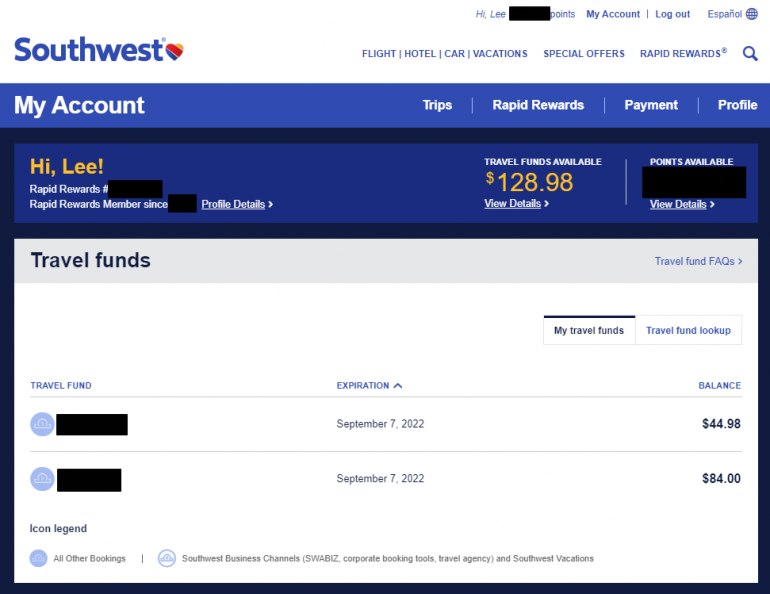
If you don't have a Southwest Airlines Rapid Rewards account, booked a flight that didn't have your loyalty number attached to it or have travel funds from a special purchase ticket, then you'll need to track them manually. Signing up for a Rapid Rewards account is free to do.
Unfortunately, you cannot manually add travel funds to your profile. To track your travel funds manually, visit the " Check Travel Funds " page on Southwest's website. You'll need to provide the passenger's first and last name plus the confirmation number from the reservation. On this page, you can also check the balance of Southwest LUV vouchers and gift cards.
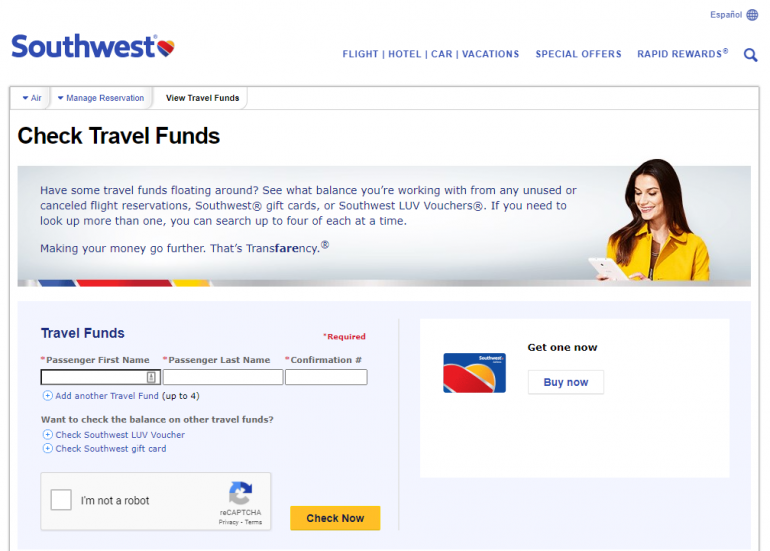
» Learn more: Don't just redeem miles — redeem them wisely. Here's how
What can I do if my travel funds have expired?
While unexpired funds and newly created funds no longer have an expiration date as of July 28, 2022, what if you have travel funds that expired just before this change in policy? According to the Southwest Community message boards, your one hope is to call customer service within six months of the expiration and ask them to reinstate your travel funds as a LUV voucher. The LUV voucher will be good for another six months from the date of your call. Southwest charges $100 for this one-time extension and it comes out of your travel funds.
» Learn more: Southwest Airlines sweet spots
What can Southwest travel funds be used for?
Travel funds from Southwest can be used to book any available cash flight or to pay for the taxes and fees on award flights. They are treated like cash and can be used to pay for some or all of the amount owed. If you don't use all of the travel funds for the reservation, any remaining balance remains for future use.
» Learn more: Your guide to booking award flights on Southwest
Can I use Southwest travel fund for someone else?
Your travel funds can be transferred to someone else with a Rapid Rewards account if you bought a a Business Select , Anytime or Wanna Get Away Plus fare. That person would have to book their own flight using the travel fund, though. You won't be able to use your travel fund to book for someone else. Wanna Get Away fares are not eligible to transferred, so they can only be used by the ticketed passenger.
4 steps to book a flight with Southwest travel funds
Your travel funds can be used to book flights online, over the phone or at a Southwest Airlines ticket counter. For this illustration, we'll focus on booking a reservation online.
1. Have your original ticket confirmation number handy
Before booking a reservation, print out or write down the travel funds reservation number(s) that you'd like to use. Southwest's website does not allow you to choose from a list during booking.
2. Browse and select your flights
During the booking process, you'll select your travel dates, cities and times as normal.
3. Apply your travel funds
When you arrive at the "Passenger & Payment Info" page, click to expand the "Apply Travel Funds, LUV Vouchers and gift cards" section. Here is where you'll enter your travel funds' confirmation number and your first and last name before clicking "Apply funds." Then, continue the booking process as normal and pay any remaining balance owed with your preferred form of payment, such as the Southwest Rapid Rewards® Priority Credit Card .
Again, you may use your travel funds for cash fares or to pay the taxes and fees on award tickets.
Remember, travel funds from other passengers may not be applied to your ticket.
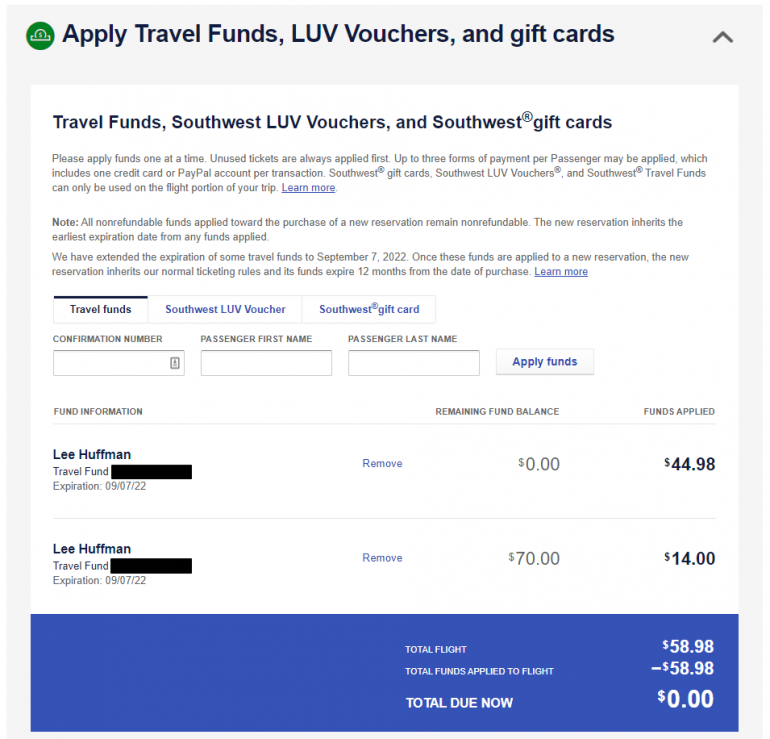
4. Get confirmation
Now that you've filled out all of the necessary information and remitted payment with your travel fund, you should see a confirmation email pop up in your inbox.
» Learn more: Is a Southwest credit card worth it?
Using Southwest travel funds
Southwest travel funds are typically created when you cancel or change a Wanna Get Away reservation. They are automatically added to your account when you attach your Rapid Rewards number to the reservation before it is canceled. These funds can be used to book cash or award travel, and any unused amount from your new reservation can be used on a future flight.
How to maximize your rewards
You want a travel credit card that prioritizes what’s important to you. Here are some of the best travel credit cards of 2024 :
Flexibility, point transfers and a large bonus: Chase Sapphire Preferred® Card
No annual fee: Wells Fargo Autograph℠ Card
Flat-rate travel rewards: Capital One Venture Rewards Credit Card
Bonus travel rewards and high-end perks: Chase Sapphire Reserve®
Luxury perks: The Platinum Card® from American Express
Business travelers: Ink Business Preferred® Credit Card

on Chase's website
1x-5x 5x on travel purchased through Chase Travel℠, 3x on dining, select streaming services and online groceries, 2x on all other travel purchases, 1x on all other purchases.
60,000 Earn 60,000 bonus points after you spend $4,000 on purchases in the first 3 months from account opening.

1.5%-5% Enjoy 5% cash back on travel purchased through Chase Travel℠, 3% cash back on drugstore purchases and dining at restaurants, including takeout and eligible delivery service, and unlimited 1.5% cash back on all other purchases.
Up to $300 Earn an additional 1.5% cash back on everything you buy (on up to $20,000 spent in the first year) - worth up to $300 cash back!
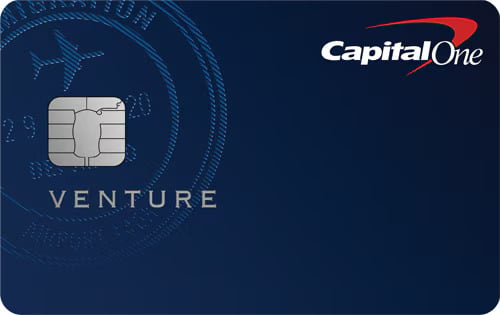
on Capital One's website
2x-5x Earn unlimited 2X miles on every purchase, every day. Earn 5X miles on hotels, vacation rentals and rental cars booked through Capital One Travel, where you'll get Capital One's best prices on thousands of trip options
75,000 Enjoy a one-time bonus of 75,000 miles once you spend $4,000 on purchases within 3 months from account opening, equal to $750 in travel.


How to Start & Save for a Travel Fund: An Expert’s Guide!
Last Updated: March 30, 2021
*FYI - this post may contain affiliate links, which means we earn a commission at no extra cost to you if you purchase from them. Also, as an Amazon Associate I earn from qualifying purchases. Check out our Privacy Policy and Disclosure. for more info.

“How I fund my travel” is a topic bloggers often tackle… but let’s be honest: the ‘tips’ aren’t usually the most helpful.
I mean, it has become a pretty unrealistic trend among bloggers that travel funding is as simple as tossing some coins into a piggy bank or cutting back on Starbucks.
… which is the least helpful financial advice ever.
And while I’ve also written about the ways you can save money for travel , here’s the thing: the way that travel bloggers afford travel is very different from the average person.
For one, we’re often able to score discounts and complimentary goods by virtue of our work, and often have the privilege of a ‘digital nomad’ lifestyle where we’re not tied down by responsibilities or *gulp* debt.
That’s why I wanted to bring you advice re: how to fund travel from a more helpful and relatable perspective – specifically from a non-travel blogger, and most importantly, a personal finance expert!

Save this guide on how to start and save for a travel fund!
You (and your travelling fund) will be very glad you did.
Today, I want to introduce you to Theresa Gray , a financial fitness coach who has eliminated over $110,000 of debt for herself, and now makes a living helping others do the same.
This lady knows finance much better than me (or most travel bloggers), which is why I trust her to give you the low down on creating a solid vacation budget, along with ideas on how to start a travel fund, save for a travel fund, and create a travelling fund that will finance your trip ideas for years to come.
In today’s guest post, Theresa is going to walk you through step by step how to start a fund for your travels, how to develop a badass vacation savings plan and yenno, eventually tick off yet another adventure for that bucket list. Take it away, Theresa!

Guest post by Theresa Gray, MoneyMatters.life
Picture yourself on an all-expenses-paid dream vacation.
Imagine how it feels to not worry about the costs of food or drinks and to feel free to book an extra unplanned massage.
It’s an awesome vision, right?
The sun shines a little brighter when you don’t have worries about the cost of travel.
However, often when we travel, we might think that we have most of the costs covered, and then get some surprises and just put it on a credit card.
You might stress about the costs while you are on holiday, but most of the time it doesn’t become a reality until you get home and see the bills from the trip and realize just how often you swiped plastic.
So, unless you are planning on being a winning contestant on “The Price is Right”, you need to learn how to save up money to self-fund your trip. And, I want to show you how!
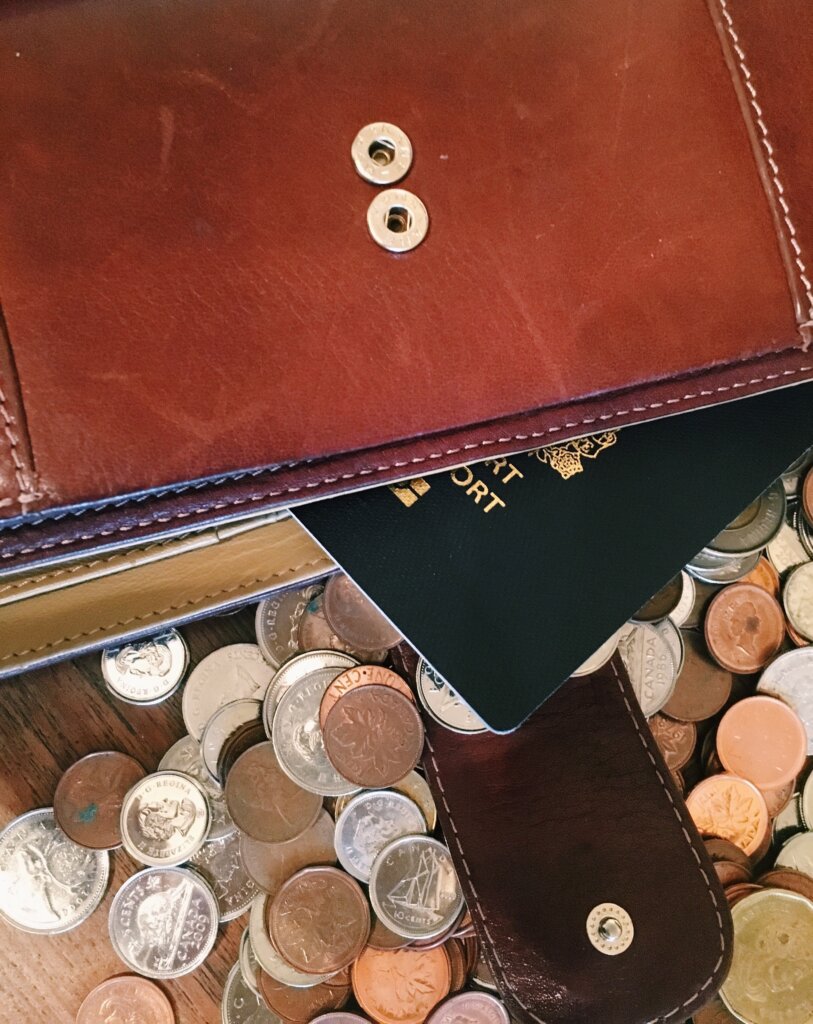
My name is Theresa Gray, and I’m obsessed with helping people to create budgets so that they can live within their means, pay off their debt and have the life that they dream about.
My whole back story is here , but basically, my husband and I changed our lifestyle, lived on a budget, and paid of $110,000 in debt in just 38 months.
Our destination was ‘Debt Free’ and once we got there we rewarded ourselves with a pre-paid self-funded dream vacation to Machu Picchu and Rapa Nui (Easter Island).

No matter if your destination is ‘Debt Free’ like us, or a travel bucket list item like Oktoberfest in Germany , Christmas markets in the Alsace , or seeing Keukenhof in the Netherlands , I can show you how to make the sun shine a little brighter when you get there.
It’s not hard!
The steps are identify, quantify, prioritize and execute.
See? Easy peasy.
(Don’t you hate it when people can’t speak plainly and they try to make themselves sound smarter?) I do. So, here are the steps, in a much easier to understand format.
Step one: Pick your destination Step two: Research costs Step three: Decide how much you want it Step four: Do the work
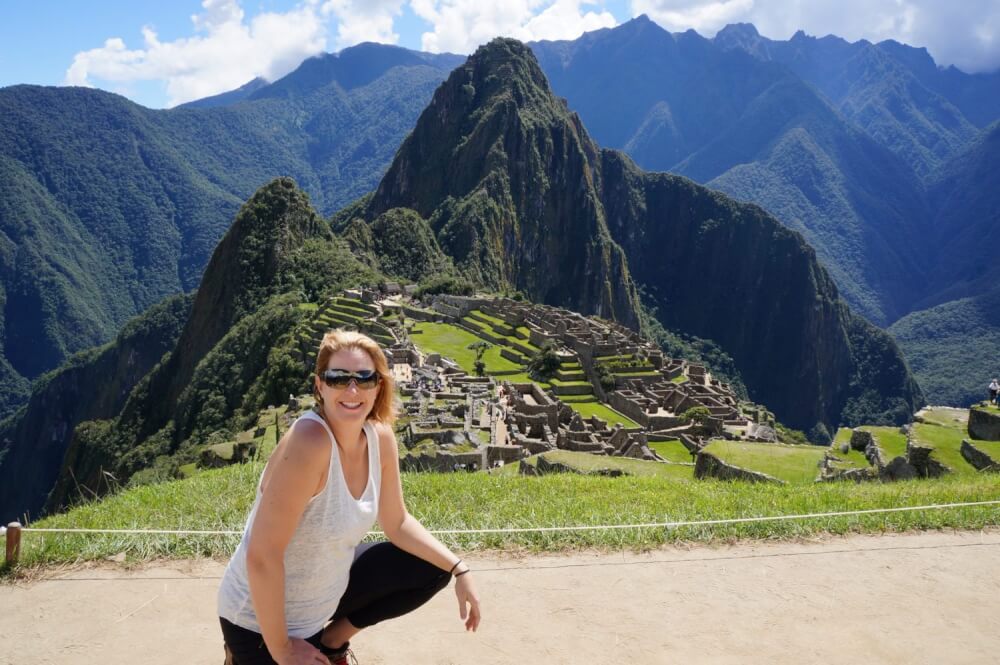
Step one: Pick your destination
Pull out your list. Surely you’ve made a list of places that you dream about visiting!
If you haven’t made one yet – get started! Here’s some wanderlust inspo for you.
I used to have distant thoughts that went “someday I’d like to go to Australia” and “maybe when I retire I can travel the world”.
But, why wait?
We don’t know how long we have on this earth, so figure out now what you want to do and where you want to go.
Do it now and then rank them in order of the top five places.

Don’t worry about details or costs or distance or if it’s even a place. Go ahead and put Atlantis on your list. I have Wonder Woman’s island of Themyscira on mine!
Cool. Now talk about this list with someone. Dream a little out loud and see how it feels.
Do you feel more drawn to one place than another? Does anyone have insider access or personal information to share to help you make your decisions?
Do some research to see what options you might have to go where you want.
Consider when you would want to go, and what type of season is available for visitors. Experiencing Spring in Europe for instance is very different from going during the winter.
We (unknowingly) went to Rapa Nui in an off season. Bad: We were one of the few people on the island who spoke English. Good: We didn’t have to deal with crowds and the scenery was more beautifully lush because it was the rainy season.
It might be cheaper in the off season, but it is a calculated risk.
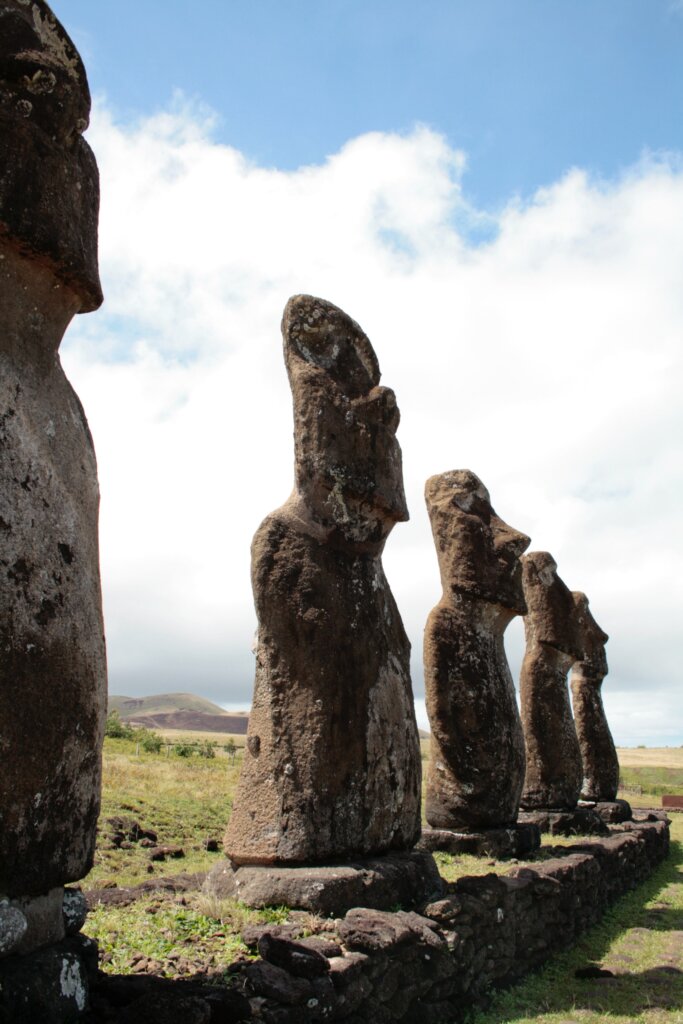
Step two: Research costs
This is the part of the process when we do have to get back to reality.
A trip to the moon is a cool conversation started on your lists, but probably cost prohibitive.
How much do your choices run?
This might help you to decide which item on your list to focus on NOW. Remember you can always do the other items in the future.

So – decide how much the actual trip costs. Calculate the obvious costs and the hidden costs.
- Obvious costs: airfare , lodging, food, souvenirs, alcohol, tips, insurance
- Hidden costs: home maintenance, pet sitter, purchases for trip (clothing, chargers, cameras, specialty gear), sun protection, new luggage, cute little toiletries, massages, parking at the airport, travel costs (uber, taxi, rail), tours once you arrive, laundry service
How much money do you need for trip? Come up with a realistic range of costs.

Step three: Decide how much you want it
Now is when we have to keep ourselves from saying, “no duh, I want it or I wouldn’t have gone through those previous steps”.
The question isn’t “do you want to go to Themiscyra?” It is, “Do you want to keep the status quo, go on the trip and return with huge debt” OR “Are you willing to change your behaviors to pre-fund your trip so you an enjoy it without guilt”.

The difference is crucial to you going on your trip and having it paid for in advance.
Either way is cool. You’re not a bad person if you use your credit cards.
However, you might regret it later when you are struggling to make the payments.
Especially if overspending becomes a way of life, if you lose your job, if you have an accident or if you have a health crisis.
If you are committed to changing your behavior and saving for your trip (or paying off debt), then we can move to the next phase!

Step four: Do the work
All your hard mental work has paid off – we have a destination chosen and know roughly how much money we need to fund the trip.
Now we need to fill up that fund!
The ways to do that are:
- Make more money
- Sell some stuff
- Cut expenses
- Stay focused by creating a budget

If you think that you do a great job at your current job, document why you think so and take it into your boss and ask for a raise.
If you have a decent job but need to make some more money, consider taking a temporary extra job to earn some money to put into your trip fund.
Here is an article I wrote with a list of suggested “side hustles”.
Remember that this extra money is going to your Trip Fund and don’t be tempted to spend it.
It’s easy to make $50, and think “hey, I have an extra $50 to spend”, and then spend it three different times, resulting in overspending of $100 instead!

If you are anything like me, you have stuff. We are a nation of stuff!
George Carlin does a funny skit about how we love to get more stuff and don’t feel comfortable until all our stuff has a home.
I’m going to throw it out there that most of us aren’t living a minimalistic life and we all have more stuff than we have places to store our stuff. Let’s call this clutter.
Clutter is stuff without a home. And this clutter in your home causes you stress!
Messy homes and work spaces leave us feeling anxious, helpless, and overwhelmed.
Have you ever thought, “I just can’t think right now!” while standing in a messy room?
Then after taking the time to clean up you can focus clearly? It’s interesting how a clear workspace can give you mental clarity!
You can sell some of that clutter and profit. I have a huge guide on decluttering and reselling here!

Cut the fat:
How fast do you want to take that trip?
There are many ways to save money for travel . You can cut back a little on Starbucks and pedicures and go in two years, or go big and cut cable, return your leased car, and go visit Wonder Woman ancestral digs by Christmas.
It’s your life so it’s your choice – and it’s really fueled by Step 3 above – “How much do you want it?”
You might be thinking, “how do I cut the fat and how much do I need to do it?” Great questions! Creating a budget will help to give us the answers.

This is your income and expenses, charted out for each month.
Ideally, each month you should be spending less than you make, have money put aside for savings (emergency fund/retirement/special occasions, etc.), be working on paying off your debt and also be making some charitable donations.
And – get ready for this – you should do this EVERY month for the rest of your life.
Yes, I’m serious.
It’s a lot of work at first – but I swear it will make your life so much better in the long run.

Remember how I got that sweet trip to Machu Picchu and Rapa Nui? Budget.
And, how I paid off $110k? Budget. I even got a really nice new couch.
Boom. Thank you, budget.

How to Build Your Own Budget
Wondering how to fund your travels smartly with a traveling fund that can help finance your trip? It all starts with a budget. Here are some must-know tips on how to budget:
1. Budget before the month begins
Start with your income.
Whether you get paid a regular salary or an irregular commission, you need to look at the month ahead and decide on a safe number to forecast.
This includes anything you earn money from, like paychecks, side jobs, child support, or alimony.
(Unless, like in this case, where we are specifying ahead of time that all NEW EXTRA money is going straight to the Trip Fund.)

Next, identify your regular monthly expenses.
Start by covering the essentials which are food, clothing, transportation, shelter, and utilities. When you know you can keep your lights on, feed your family, and drive to work, you can focus on the other important expenses like savings, health insurance, and debt repayments.
Don’t forget to give away some of your money, to put your priorities in focus. If 10% is uncomfortable, start with an amount you feel comfortable with and then try to increase your percentage.
As you budget each month, remember that no two months are exactly the same.
It’s okay to use last month’s budget as a template, but be sure to tweak it for any new expenses on the horizon.
At the end of the day, this is your budget. Make it awesome by budgeting early, spending every dollar on paper down to a zero on the bottom line, and tracking your spending.

Finally, after everything you need to pay for the month has been accounted for, it’s time to consider what to do with your ‘want to do’ dollars.
This is where you get to see how much per month is left over for your Trip Fund, and you can begin to calculate how long it will take to fill up the fund.
If your monthly trip/traveling fund amount is small, it will take a long time to finance the trip.
So, now you need to cut some fat. Where in the regular monthly expenses can you cut back stuff?
Often the biggest spots where we overspend are where we live, what we drive, and what we eat.

2. Budget to zero
Now that you’ve accounted for all of your income and expenses, you should have zero dollars left to spend. If you don’t, adjust your budget until you do.
This is your number-one goal when allocating your income each month. By giving every dollar a name, you’re ensuring that every dollar is accounted for and working hard.
And, that my friends, is budgeting.

3. Track your spending
This budget needs to mean something more than just an exercise you do on paper.
If you budget $200 a month for clothing but then go and spend $500 you broke your budget!
While you’re out and about buying groceries or eating at restaurants, be sure to track your transactions.

What does that mean, ‘tracking transactions?’
It is making sure that if you spend a dollar, that it gets noted as being a dollar ‘spent’ for a specific budget.
So, if I have a $30 Starbucks monthly budget, and I go and get a $5 latte on the first and second days of the month, I need to know that I only have $20 left for the rest of the month.
I can do that a few different ways.
I could have a manual ledger (in a note pad) of how much I’ve spent to date per category and write down all my expenses and assign them to categories as I write them down.
I could pre-portion budget categories using cash envelopes and only spend out of the appropriate envelope and I would see exactly when I am out of cash!
Or, if I use a lot of debit or credit cards, I can use an online tracking program (like Mint or Quicken, etc.).
There should be NO UNCATEGORIZED transactions at the end of each month! No ‘miscellaneous’ transactions!
This means that when you shop at Target, you will need to split apart the transaction and divvy up the spending into correct categories (food, toiletries, clothing) and not leave in a ‘shopping’ catch-all.
The first couple months can be tricky to get the numbers right, but after 3-4 months of tracking and adjusting you will get the right balance of money in each category and start to take charge of your finances.

By this time you will have sold some stuff and made some extra money.
By knowing your budget, you will be able to calculate how much you can put in your trip budget per month and then calculate how long until you have your trip funded!
Trip Costs – Profit from Sales – Side Hustle Cash = Total $ Needed to fill Trip Fund Total $ Needed to fill Trip Fund / Budgeted Trip Savings per Month = # Months until Trip Fund is Full
And once you know when you will be ready to go on your pre-paid vacation, you can start to book your travel and start to see your dream become a reality!

Then it starts to get even more exciting! You might get even more motivated and figure out how to save more money, faster to fund the next trip on your list!
You can put whatever you want on your budget. It’s your baby. But if you are only wishing for something, odds are it won’t happen. Make a plan and live your dreams!
I hope that this helps someone to finally feel like they can afford to take a dream trip. Have any questions? Be sure to stop by my site!

I hope you enjoyed this guide to starting your own travel fund!
Hey, it’s Christina again! I hope you enjoyed that guest post from Theresa – I know I definitely learned a lot about how to create a fund and budget to help fund my travel, finance my trip goals in the future, and even start a vacation fund for those huge bucket list trips.
If you need more inspiration on what to do with your travelling fund, be sure to check out my Destinations page for ideas.
My Go-To Travel Favourites:
🧳 Eagle Creek: My favourite packing cubes
💳 Wise: For FREE travel friendly credit cards
🍯 Airalo: My go-to eSIM
🏨 Booking.com: For searching hotels
📷 Sony A7IV: My (amazing) camera
✈️ Google Flights : For finding flight deals
🌎 WorldNomads: For travel insurance
🎉 GetYourGuide: For booking activities
5 thoughts on “How to Start & Save for a Travel Fund: An Expert’s Guide!”
Glad to say that I do all of these things before travelling! I always make sure I have emergency money as well, in case anything happens and I need to fly home – touchwood! That’s why more expensive/far away destinations are out of the picture at the moment, but maybe some time in the future! – Charmaine Ng | Architecture & Lifestyle Blog https://charmainenyw.com
That’s awesome – good for you haha. You’re way more on top of finances than I am haha.
Glad you liked it!
Hey Christina, The more I read your blog content, the more I feel inspired. These are amazing budget building strategies. The whole purpose of my blog is the same! To enable people to travel in shoe string budgets. Would request you to go through the same and give your valuable suggestions. http://www.wanderwithsankalp.com
Leave a Comment Cancel reply
By using this form you agree with the storage and handling of your data by this website. *

Travel Fund: 22 Ways to Save Money for Travel
So you want to travel the world. The first thing you need to do is start a travel fund. The good news is that it’s possible! The bad news (if you consider this is bad news) is that starting a travel fund will take a little bit of dedication, priority and time.
I’ve had travel funds as long as I can remember. I started to save money for travel in high school by working at a coffee shop on the weekends and off seasons when I wasn’t playing sports.
The summer before I college I took a trip to Aruba with my best friends. My first international trip and I paid for it all on my own by working a minimum wage job. I was hooked.
There were so many ways to save money on a tight budget. As well as many ways to save money while traveling .
Fast forward 18 years, my travel funds keeps getting larger because my desire to travel more places and for longer periods of time keeps getting more intense.
Table of Contents
22 Ways to Save for Travel

For full transparency, I have sprinkled some affiliate links in this post which gives me a small commission at no extra cost to you if you decided to make a purchase. As always, I would never recommend a product or service that I didn't truely believe in. If you find this post useful, you can also treat Jess to a cup coffee by clicking the icon on the bottom of the page. This will allow me to continue to create more content for you to enjoy ☕️.
How to Start a Travel Fund
1. prioritize.
The first step to starting a travel fund is to make it a priority. No person working a regular working a minimum wage job has ever saved enough money to travel the world without making a few sacrifices. Is that $100 concert a necessity or can you put that money towards your travel fund?
Let’s take a look at my story. I’ve been a bartender since I was 19 years old, I am currently 35 and still bartend to fund my travels (along with a few side hustles and tricks I mention in this post).
I say this because I want you to know that I wasn’t blessed with a trust fund or left a high paying corporate job to travel. I worked my ass off, had multiple jobs, saved as much money as I could and used all these tips I’m writing about on how to save money to travel the world in order to budget for travel.
It wasn’t easy and it didn’t come without sacrifice. Saving money for travel was my top priority and you will need to set your intentions early and stay focused.
2. Attack your Debt
Of course in order to start a travel savings you must first get out of debt. It may seem daunting at first because all of the money you are saving is going towards your debt and not your travel fund but trust me, this is the only way.
I was twenty two thousand dollars in credit card debt, got a second job, cut out unnecessary spending and paid off my debt while saving 20k in a travel fund all within a year while living in expensive Maui . I don’t say this to brag, I say this to let you know that if I can do it, you can do it.

3. Start a Seperate Online Savings Account for your Travel Fund
After you’ve set your intentions and you’ve made starting a travel fund a priority, the next step is to start a separate savings account that will house your travel savings.
You can do this through your hometown bank or what I recommend doing is to start an online banking account through Charles and Schwab. It is easy to set up and you can do so here . If you sign up through this link you can earn up to an extra $500 depending on how much you deposit. What a perfect way to jumpstart your travel fund! P.S. I get no incentive for you using this link, its all you baby! Save on my friend!
Once you’ve set up your online travel savings account you can link your original account and easily transfer money into your savings electronically. So every time you deposit money you can decide how much is going into your travel fund, transfer it over and forget about it.
I recommend banking with Charles and Schwab for several reasons.
First, they have great customer service. One time I was traveling through Thailand in Southeast Asia when I realized that my debit card was about to expire and that was my only way to withdrawal money. I made a call to customer service and within 3 days I had a new debit card delivered to my hotel in Chiang Mai .
I then proceeded to accidentally leave my new unexpired debit card in an ATM. Not my proudest travel moment. I then had to wait until I was going to be in one spot for at least one week to have them send me a new bank card. This time it was in Vang Vieng, Laos , where I again called and my second new debit card had arrived within 3 days.
If you know anything about Laos or Vang Vieng in general you know how remote and difficult it is to get to. Charles and schwab was there for me when I needed them and I will forever by a loyal customer.
Second, when you use you Charles and schwab card anywhere in the world, they reimburse your foreign transaction fees . This way you never have to be carrying a bunch of cash on you, you can pull out what you’ll spend for the day or two and it’s still cost effective because you’ll be getting back what you spent on atms at the end of each month. It’s safe and it saves. Win win.

4. Track your Expenses
Write down all of your bills for one month. Rent, electric, car payment, insurance, subscriptions, student loans and tally it up.
Next track your expenses for a week, record everything that you spend your money on. That morning coffee, parking, laundry, night cap, whatever it is write it down and see on average how much you spend a week. Once you’ve finished tracking your expenses for a whole week multiply that number times 4, this will be your average expenses you spend in a month.
There are lots of apps out there to help you track your expenses but my favorite is the Trail Wallet Travel Budget App . This app let’s you track your expenses by categories and its easy to use. Plus it was designed for travelers, you can easily switch between currencies and getting in the habit now to track your expenses will be a breeze when you are actually traveling.
Okay so you have your total bills for the month and roughly what you spend in a month on things other than bills like groceries and nights out. That number may scare you but this is a good thing because now you cut the fat. All the frivolous spending has to go in order to watch your travel savings grow. Time to put yourself on a strict budget. Here are some common ways to do this.

Expenses to Cut to Save Money to Travel

5. Cut the Coffee
If you spend $5 a day on a fancy coffee that’s $35 a week and $140 a month. Cut the coffee and make it at home.
6. Ditch the Gym & Workout at Home
Although I don’t personally use this one because my gym is my outlet, cancelling your gym membership can potentially save you a lot of money for travel.
If you go this route utilize Youtube. There are lots of free workouts online that can get your blood pumping and of course running is always free.
Related Articles:
20 Pieces of Workout Equipment you can Travel with 10 Ways to Stay Fit while Traveling
7. Trade Nights out for Dinner Parties
Just because you are on a budget doesn’t mean that you can’t enjoy your friends and have fun. Instead of going out to dinner opt for dinner in with friends. You’ll have more meaningful conversations, learn a new skill like cooking and its cost effective.
8. Cut the Extra Montly Subscriptions
Do you really need that Fab Fit Box or Wine of the Month Club? Cutting expenses means getting rid of unnecessary expenses. You can’t bring all that stuff with you when you travel anyways.
If you still pay for cable, stop right now. Stream your shows instead. If you have T-Mobile (one of the best international phone plans out there) Netflix is included with your plan. Consider switching carriers.
10. Stop Drinking
One of the biggest travel saving tips I have is to stop drinking. Drinking is not only bad for your waistline, its also bad for your budget.
If you’ve ever worked in the restaurant industry, after your shift you go to the l ate night bar for drinks to talk with your co-workers and talk about your night. Once I stopped doing this I saved hundreds of dollars a month. Cutting this expense for me was the easiest way to save for a trip.
11. Don’t Smoke
A pack of cigarettes cost $10 in Hawaii , you do the math.

12. Enjoy Free Activities
Just because you put yourself on a budget doesn’t mean you have to deprive yourself of fun activities. Enjoy free things like hiking or utilize a museum that is free to get into.
HIKING INSPIRATION:
Maui’s Best Hikes The Best Hikes of Zion National Park Epic Hikes in Peru
Hiking Arches National Park Hiking Bryce Canyon National Park Hiking the Great Wall of China without the Crowds Hiking Rio Celeste, Costa Rica
13. Use Public Transportation when you can
Save on gas and parking expenses by taking public transportation. Not only is it budget friendly but its eco friendly as well.
14. Buy in Bulk
Here on Maui groceries are expensive along with everything else. Buying in bulk is a great a way to save money for your travels.
This makes it easy to meal prep and have meals and snacks ready to go. This is especially helpful if you are living a busy life and working two jobs to build up that travel fund. When you’re busy people pay for convenience which counter acts the whole point of working a second job in the first place.
15. Shop at Farmer’s Markets
You don’t need to just shop at Costco to be able to save money on groceries. Farmers markets are usually priced cheaper than normal grocery stores and it helps support local business.
16. You Don’t Need the Latest & Greatest
Do you really need the latest iPhone or that brand new purse? Buy used or last season and utilize online sales that usually happen around the holidays.
Uncover your hidden talent and become a coupon queen. Every penny counts.
17. Go Green
First stop buying plastic . Opt for using reusable water bottles and tupperwares instead.
Swap your current lightbulbs for energy efficient ones . The most popular energy saving light bulbs are halogen incandescents, compact fluorescent lamps (CFLs), and light-emitting diodes (LEDs). Although they can initially cost more upfront, it saves you money in the long run because they use less energy.
Solar panels . Another idea that will cost more money upfront but will save you money long term and a travel savings is all about the long term goal.
Read Next: The Best Reef Safe Sunscreens for your Face
18. Don’t Own Pets
I know this isn’t an easy one and if you already have pets you can’t change this. But this travel savings tip is for those out there that don’t yet have a fur baby.
Unfortunately a down side to having pets is the cost. You have to buy them food, pay for unexpected vet bills and of course toys. This all adds up and what you spend on a pet could potentially be going into your travel fund.
Plus this makes it difficult to leave to travel the world especially if you’re looking to save enough money to fund long term travel. That wouldn’t be fair to you or the animal.
Ways to Get More Money for Traveling

19. Get a Side Hustle
If you want to grow your travel fund to travel the world in the fastest way possible one of the best ways to do this is by getting a side hustle. I am the queen of side hustles. I am always looking for a way to earn a few bucks – what can I say, I have big dreams to build.
There are several ways to do this. You can get a second job . Whether it’s a few nights a week or on the weekends. It’s not easy working a second job, it’s time consuming and exhausting but keep your eye on the prize. You want enough money to travel the world!
You can earn extra income through an app . There lots of apps popping up that allow you to earn extra money on your own time. This makes it much more appealing than having to clock into a second job. Check out these apps to earn extra money on the side.
- Instacart – Shop groceries and deliver them to their house.
- Rover – Dog walking and pet sitting.
- Thumbtack – Put your services on the app for people to find you locally. Example photography.
Another way to make extra money for travel is working online . This is my main goal financial freedom and location independence. Making money online is the way to do this. Here are a few ways you can do this.
- Start a blog
- Take surveys online
- Have a shop on Etsy
20. Downsize
Downsizing your housing is a huge way to be able to cut expenses to travel the world. Do you really need those extra bedrooms? Downsize in space to save money on rent.
Not into getting a smaller place? Become a host and rent out a room on Airbnb
Move in with your parents. Get a roommate. Live in a van. Remember that the end goal is to travel the world and to travel for long term.
21. Pay in Bulk
Pay in bulk when you can. You’re still going to have bills that you can’t avoid like car insurance or rent. Most services offer a discount if you pay in full.
For example I always pay my car insurance in bulk every six months. This saves me about $120 and it feels good to know that its already paid off.
Watch your Travel Fund Grow
I hope you found all these tips on how to save money to travel useful and you can now watch your travel savings grow. With a little time, a little patience, a focused vision and upbeat attitude your hard work will pay off and soon you’ll be on that world wide adventure.

22. Put Everything on a Credit Card with Huge Travel Benefits
Another way to earn money for travel is to use credit cards for purchases to earn miles and quickly pay off the balance. Paying off the balance every month is a must and the only way you will profit from this strategy.
This will help you get free flights and hotel stays which can help you travel for longer. These are a few of the best credit cards for travel.
- Chase Sapphire
- Amex Plantinum
- Capitol One Venture
- Hilton Honors
That’s how to save money to travel. Do you have any money saving tips that has benefited you on your travel savings journey? Let me know in the comments below!
More budget tips & travel tips ↓.
10 Tips to Survive a Long Haul Flight
35 Useful & Unique Travel Accessories
The Best Travel Gadgets for Backpackers
How to Travel Maui on a Budget
Things to do in Maui on a Budget
Enjoy this Post?!?! Pin in for Later ↓

Submit a Comment Cancel reply
Your email address will not be published. Required fields are marked *
Save my name, email, and website in this browser for the next time I comment.

Hi, we’re Jess (& Joe). We hope you’re enjoying our free travel guides and tips. If so please consider buying us a coffee ☕️. We appreciate your support!

🎥 Do you follow us on You Tube? Subscribe to follow along on our adventures!


CEBU PACIFIC: How to Convert Your Ticket to a TRAVEL FUND

When your Cebu Pacific flight is canceled or rescheduled, the airline provides options on what to to with your booking. You can rebook , request a refund , or convert your ticket to a travel fund .

WHAT'S COVERED IN THIS GUIDE?
What is a travel fund?
In the context of Cebu Pacific, a travel fund a virtual wallet where you can transfer the cost of your ticket, which can then be used to pay for your future bookings. The amount to be transferred excludes insurance add-ons and other service fees, if any.
For example, let’s say that my Manila-Cebu flight was canceled. Instead of rebooking it or asking for a refund, I can have that amount be stored in my Travel Fund. In a way, it’s like I have credits that Cebu Pacific is keeping for me. Now, in the future, when I decide to book another flight with them, I could use it to pay for that new booking.
You can keep that amount for 90 days (in some cases, 180 days), which starts on the day of conversion. If you fail to use it within that period, it will expire. You can also use it only for the original passenger.
But unlike refunds which usually take weeks (or even months) to complete, you can use a travel fund quickly and easily. If I convert my ticket to a travel fund today and I choose to book another flight tomorrow, I can already use the credited amount. If you can’t wait for a refund, this is a good option, provided that you are certain you will be using it within the next 90 days.
How to transfer your ticket to a Travel Fund
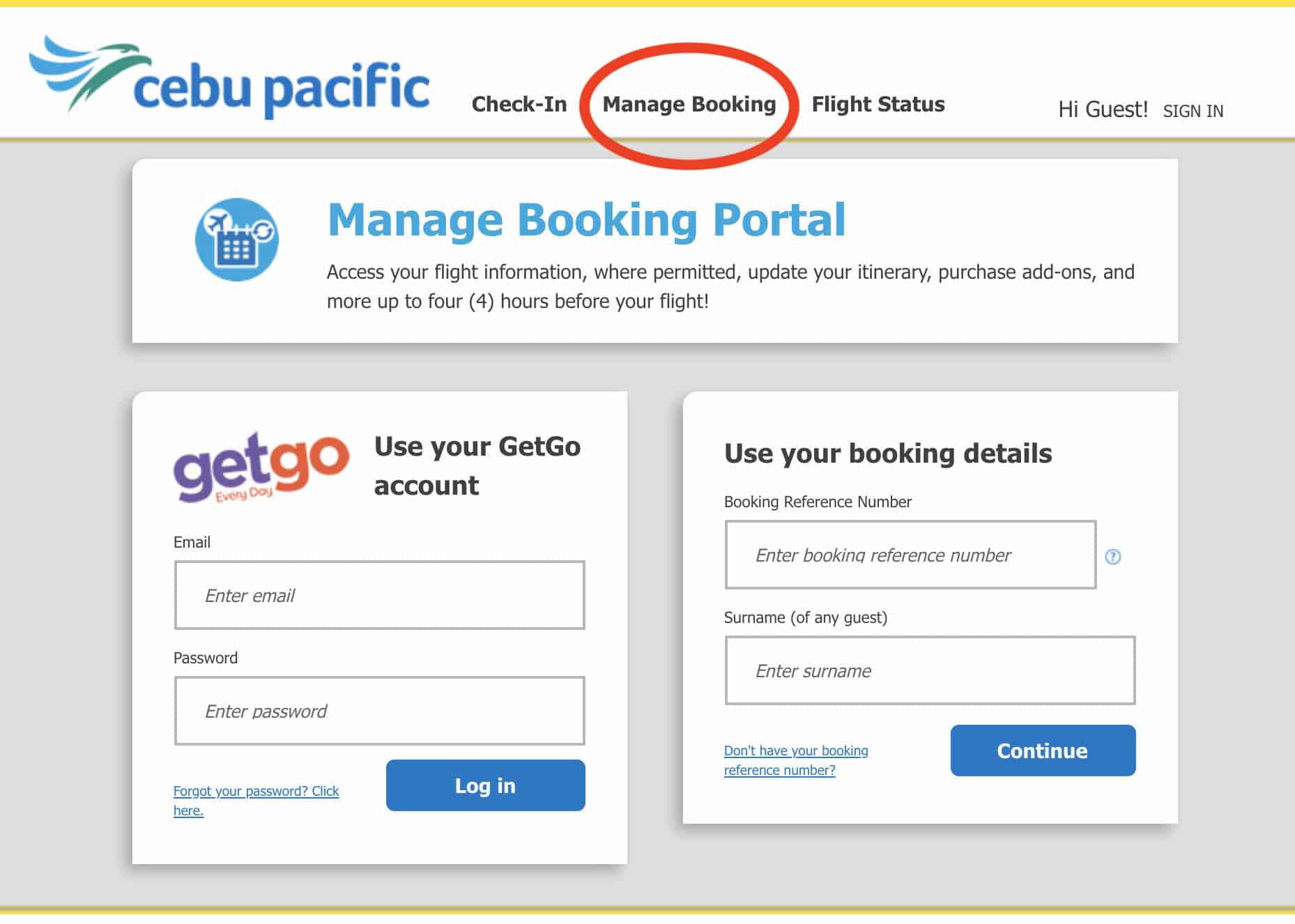
- Visit the Cebu Pacific website: www.cebupacificair.com . Click on MANAGE BOOKING.
- Supply the information needed to access your booking: Booking Reference Number and Surname of the passenger. If you have a GetGo membership, log in to your account.
- On the dashboard, find your flight. Click the MANAGE button next to it.
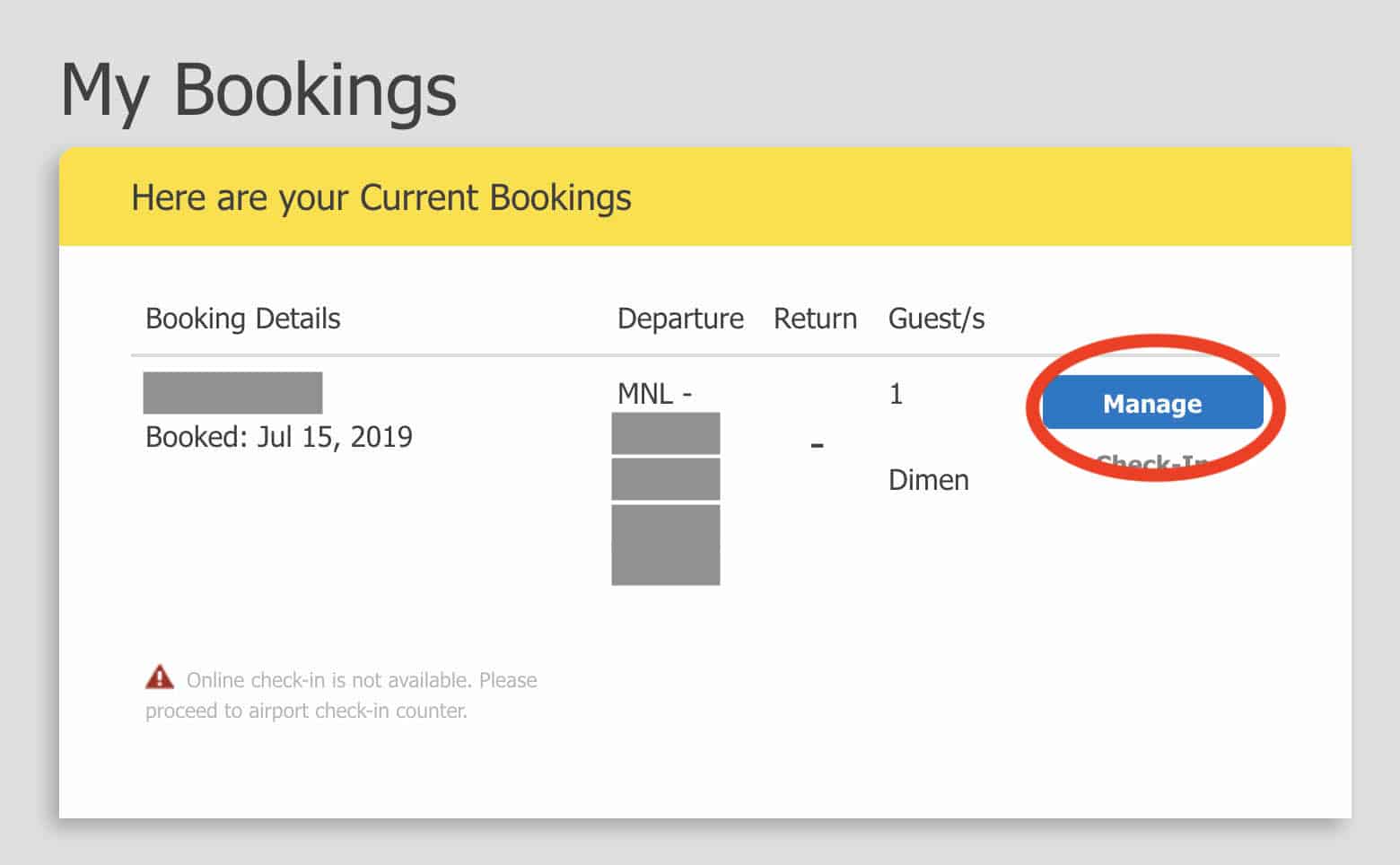
- On the next page, you will find icons. If your flight has been canceled by Cebu Pacific, you will find a TRAVEL FUND option. If your flight isn’t canceled, choose CANCEL FLIGHT and follow the next steps.
- Enter the information asked on the next page.
- Confirm transfer to Travel Fund.
When it’s done, you should receive an email from Cebu Pacific stating that the price of the ticket has been converted into Travel Fund credits.
Here’s a quick infographic summing up the process:
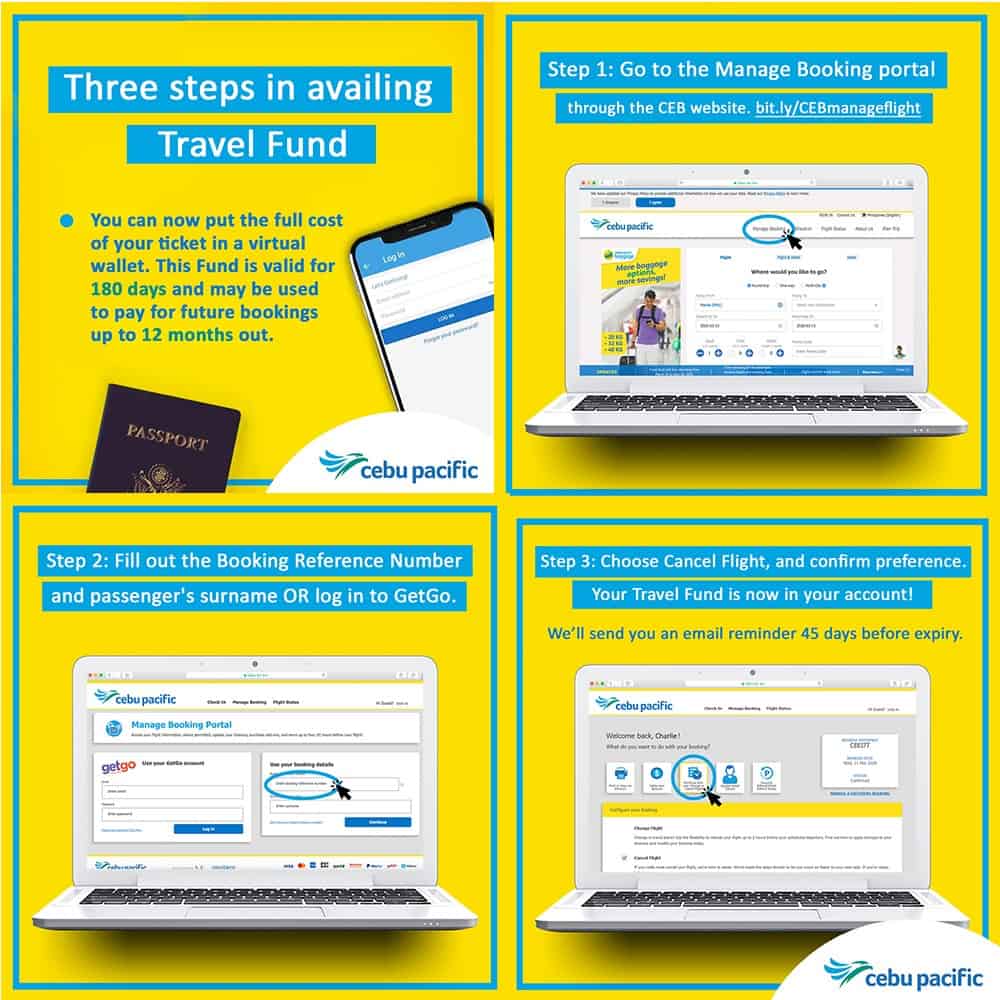
Frequently Asked Questions
Who can avail of travel fund.
Generally, if the airline cancels or reschedules your flight with 1-hour difference, you are entitled to a rebooking, refund, or travel fund. Note that there should be at least a 1-hour difference from the original schedule.
If you voluntarily cancels your flight, you may be entitled to these options depending on your fare type. Most promo fares are not covered. Other cases like death or serious illness or injury of the passenger can also be a reason for a refund or conversion to travel fund. You will need to submit a valid certificate and other necessary documents.
My flight has been rescheduled, can I avail of the Travel Fund option?
Only when there is a 1-hour difference between the original schedule and the new schedule. Otherwise, you are not entitled to a travel fund, refund, or rebooking.
Will the travel tax be included in the conversion to Travel Fund too?
The travel tax will not be included in the converted amount at first, but it will be added within 15 days after completing your booking conversion to Travel Fund.
Travel taxes are processed separately and entail coordination with other agencies, but it will be added eventually.
How to use Travel Fund to book another flight?
When you decide to use Travel Fund credits to purchase another ticket, simply book a flight on the website or app as you normally would. The difference is: on the PAYMENT page, when asked how you want to pay, choose the TRAVEL FUND option.
If I had my ticket converted to Travel Fund, could I change my mind and ask for a refund?
NO. If your flight is canceled or rescheduled (with 1 hour difference), make sure you weigh your options carefully before making a decision. Once it’s done, it is final and irreversible.
If the validity of the Travel Fund expires, will I still be able to use it?
NO, not anymore.
You will receive an email reminder 45 days before the travel fund expires. Remember, the travel fund’s validity is 90-180 days (depending on the case) from the day of conversion.
Is there a fee for converting a ticket to Travel Fund?
If it’s the airline that canceled or rescheduled your flight, it’s FREE OF CHARGE.
But if it’s you who canceled, the airline may charge a processing fee.
Can I use the Travel Fund for another person?
NO. It is non-transferable. It may be used for the same person on record.
There are multiple passengers in our booking. Are all of us entitled to use Travel Fund?
Here’s what Cebu Pacific’s Terms has to say about that:
“Multiple passengers named in one Itinerary Receipt will have the option to create a single fund that may be redeemed by anyone in the record or to split the fund to allow each passenger on record to get his share. Except for this instance, the airline will follow a one booking-one Travel Fund policy. A single Travel Fund cannot be created out of multiple bookings, as the Travel Fund is associated with the passenger’s booking reference and not with his name.”
2020 • 3 • 15
More Tips on YouTube ⬇️⬇️⬇️
Is this post helpful to you?

Related Posts:
- HOW TO GET A REFUND ON TERMINAL FEES & TAXES: Cebu Pacific, AirAsia, Philippine Airlines
- CEBU PACIFIC: How to Get a REFUND for Canceled or Rescheduled Flights
- AIRASIA: How to Get a REFUND for Canceled or Rescheduled Flights
- How to Easily REBOOK your CEBU PACIFIC Flight Online
- HOW TO BOOK CHEAP FLIGHTS SUCCESSFULLY
- CEBU PACIFIC Flights from June 1-September 30: How to REBOOK or Use Travel Fund
- PHILIPPINE AIRLINES: List of Operational Flights for JULY 2020
- CEBU PACIFIC SCHEDULE: List of Operational Flights for DECEMBER 2020

- Recent Posts
- Top 35 BANGKOK Things to Do & Places to Visit - 28 July 2024
- 2024 STILTS CALATAGAN Beach Resort Travel Guide with Itinerary & Budget - 7 April 2024
- TOKYO SKYTREE TRAVEL GUIDE: Know Before You Visit! - 30 March 2024
good evening po. naprocess napo yung cancellation ko ng flight. san po banda makikita yung travel fund?
what if I use the Travel Fund from my cancelled flight and I decided to use it on a specified date and yet I got cheaper fare on my next booking, can I add additional person to avail the fund? If in case it will be allowed and I lack fund for my additional passenger what will be my payment option? Thanks.
Good morning san ko po makikita yung ticket kung nailagay ko sa travel refund?
Hi! I just want to ask about travel fund being used by the one on record, is this pertaining to the name on the tickets that was cancelled or are you talking about the name on the account used to book the flight ?
Hello. I read in a post that one cannot use his/her travel fund during a seat sale or for promo fare. Travel fund can only be used for regular fare. Is this true?
Can I use it directly if I desired to book right after processing the travel fund? I mean I tranferred it already to Travel Fund and appeared alrady in my account.
How do i know if i already successfuly converted my booking into travelfund?how long will it takes to get an confirmation.
Good morning .where can i see the options for travel fund?.only rebooking and rerouting appears.my original flight was on april 2,2020 manila – dumaguete and april 18 dumaguete-manila .pls help thank you
Good morning po. saan po makikita ang total amount ng nasa travel fund ko at reference number nito?
Maraming salamat
Hi icoconvert ko sana yung 32,093 php to travel fund pero nung mag cacancel na po ako. 17,000 nalang. Bakit po kaya ganon? Wala naman ako matawagan sa cebpac :(
Hi po good morning po paano kopo mare book ang ticket namin kasama ko po mga anak k at bawal ang bata.april 1 pa po ticket nmin
Sayang Yung 13K na binayad ng Asawa ko sa one way ticket going to Dubai. Di alam Kung marerefund pa haisssst
I converted to travel fund got email saying all OK – but nothing in my fund ??? Is it instant or does it take some time to get the amount into the travel fund please
how to transfer my booking if we used another email add?
Featured On

We heard you!
Your comment is now queued for moderation! We’ll try to get back to you soonest. While waiting, follow us on these channels.
Subscribe on Youtube! Follow us on Instagram!

Funds “Travel” Regulations: Questions & Answers
The following is revised guidance to financial institutions on the transmittal of funds "Travel" rule. This guidance updates the document “Funds ‘Travel’ Regulations: Questions & Answers” issued in 1997. It includes a parenthetical at the end of each answer indicating the date the answer was issued.
1. Are all transmittals of funds subject to this rule?
No. Only transmittals of funds equal to or greater than $3,000 (or its foreign equivalent) are subject to this rule, regardless of whether or not currency is involved. In addition, transmittals of funds governed by the Electronic Funds Transfer Act (Reg E) or made through ATM or point-of-sale systems are not subject to this rule. (January 1997)
2. What are the "Travel" rule's requirements?
All transmittor's financial institutions must include and send the following in the transmittal order:
- the name of the transmittor
- the account number of the transmittor, if used
- the address of the transmittor
- the identity of the transmittor's financial institution
- the amount of the transmittal order
- the execution date of the transmittal order
- the identity of the recipient's financial institution
and, if received:
- the name of the recipient
- the address of the recipient
- the account number of the recipient, and
- any other specific identifier of the recipient.
An intermediary financial institution must pass on all of the above listed information, as specified in the travel rule, it receives from a transmittor's financial institution or the preceding intermediary financial institution (exceptions are noted below, in FAQ #3), but has no general duty to retrieve information not provided by the transmittor's financial institution or the preceding intermediary financial institution.
An intermediary financial institution may receive supplementary information about a payment beyond the information the travel rule requires to be sent to the next financial institution in the payment chain. For example, a payment order may contain additional information about the payment or the parties to the transaction. Due to differences in format and detail included in different systems, such as Fedwire, CHIPS, SWIFT and proprietary message formats, this additional information may not be readily transferable to the format used to send a subsequent payment order. In that event, the sending intermediary institution would be in compliance with the travel rule as long as all of the information specified in the travel rule was included in the subsequent payment order. The information does not have to be structured in the same manner or appear in the same format so long as all of the information required by the travel rule is included. For example, if certain information specified in the travel rule was present in two or more fields in the payment order received, that information need only be included once in the payment order sent to satisfy the requirements of the travel rule.
Intermediary financial institutions in receipt of additional information not required by the travel rule should note that, while compliance with the travel rule is accomplished by inclusion of the information identified in the rule, other monitoring and reporting requirements may apply to additional information and nothing in this FAQ relieves a financial institution of any of its duties with regard to other requirements. In addition, as a matter of risk management, an intermediary financial institution may choose to provide a receiving financial institution supplemental information about a payment and the parties involved. Currently, limited interoperability between systems may prevent a bank from choosing to include certain supplementary information in a payment order. These limitations, however, may be temporary as systems develop.
Moreover, if any lawful order is received at, or if a request from another financial institution is made to a recipient's financial institution, all financial institutions must go back to the transmittor's financial institution, or any other preceding financial institution, if the transmittor's financial institution is unknown, and retrieve information required by the travel rule not included in the transmittal of funds due to system limitations. (Updated November 2010)
3. Are there any exceptions to these requirements?
Yes. If the transmittor and the recipient are the same person, and the transmittor's financial institution and the recipient's financial institution are the same domestic bank or domestic securities broker, the transaction is excepted from the requirement contained in these new rules.
In addition, if both the transmittor and the recipient, that is, as defined, the beneficial recipient, are any of the following, then the transmittal of funds is not subject to these rules:
- Domestic bank;
- Wholly owned domestic subsidiary of a domestic bank;
- Domestic broker or dealer in securities;
- Wholly owned domestic subsidiary of a domestic broker or dealer in securities;
- Domestic futures commission merchant or an introducing broker in commodities;
- Wholly owned domestic subsidiary of a domestic futures commission merchant or an introducing broker in commodities;
- The United States;
- Federal agency or instrumentality;
- State or local government; State or local agency or instrumentality; or
- Domestic mutual fund. (Updated November 2010)
4. Does this rule require any reporting to the government of any information?
No. However, if a transmittal of funds seems to the financial institution to be suspicious, then a Suspicious Activity Report is required, if the financial institution is subject to the Bank Secrecy Act's suspicious activity reporting requirement. (January 1997)
5. How long does a financial institution have to keep records required by these new rules?
Five (5) years. (January 1997)
6. What is the benefit of this rule to the public?
Law enforcement authorities have identified instances to the Treasury in which records maintained by financial institutions were incomplete or insufficient and thereby hampered criminal investigations. In addition, in certain criminal investigations, financial institutions were unable, on a timely basis, to provide law enforcement authorities with useful financial records of transmittals of funds. This rule was created to ensure that in criminal investigations, as well as tax or regulatory proceedings, sufficient information would be available to quickly enable authorities to determine the source of the transmittal of funds and its recipient. Finally, it is anticipated that this rule will more easily permit law enforcement authorities to determine the parties to a transaction. (January 1997)
7. What is a financial institution for the purposes of this rule?
The term "financial institution" includes: banks; securities brokers or dealers; casinos subject to the Bank Secrecy Act; money transmitters, check cashers, currency exchangers, and money order issuers and sellers subject to the Bank Secrecy Act; futures commission merchants and introducing brokers in commodities; and mutual funds. Please see 31 CFR 103.11 for more information. (November 2010)
8. Does this rule treat banks and non-bank financial institutions differently?
No. Banks and non-bank financial institutions are treated identically under the Travel rule. (January 1997)
9. What are some of the implications of the Travel rule for financial institutions subject to this rule?
The most important implication is that financial institutions must be aware that if a transmittal of funds involves both bank and non-bank financial institutions, each financial institution must carefully analyze and understand all of the definitions that apply to its role in the transmittal of funds. This is important because the rule's requirements on financial institutions differ, depending on what role a financial institution plays in a transmittal of funds.
For example, in a situation in which the customer of a securities broker initiates a transmittal of funds that is sent through a bank, that bank is an intermediary financial institution for the purposes of the Travel rule.
The next important implication is that financial institutions must carefully understand the role of the succeeding financial institution in the chain of each transmittal of funds, particularly where a transmittal of funds moves from a bank to a non-bank, or vice versa. This is important because the Travel rule's requirement to pass information to the next financial institution in the chain implicitly requires financial institutions that carry out transmittals of funds to coordinate the transfer of information required by this new rule.
Finally, as the range of services offered by financial institutions expands, financial institutions must recognize that a single transmittal may involve two or more funds transfer systems. In such cases, it is important that financial institutions understand their roles in such a complex transmittal of funds, because their duties under this rule arise from their role(s) in the transmittal of funds. (January 1997)
10. What is the relationship between the terms used in this rule and those used within Article 4A of the Uniform Commercial Code (UCC)?
This rule uses terms that are intended to parallel those used in UCC Article 4A, but that are applicable to all financial institutions, as defined within the Bank Secrecy Act's implementing regulations.
(January 1997)
11. Do the terms created in this regulation apply to transmittals of funds to or from anywhere in the world?
Yes. However, the requirements of the Bank Secrecy Act apply only to activities of financial institutions within the United States. Thus, for example, part, but not all, of an international transmittal of funds can be subject to the Travel rule. (January 1997)
12. Is this rule limited to wire transfers?
No. The term transmittal of funds includes other transactions and transfers in addition to wire transfers or electronic transfers. (January 1997)
13. What are examples of transmittals of funds that are not wire transfers?
Financial institutions sometimes carry out transmittals of funds using correspondent accounts or journal entry transfers such as "due from" and "due to" accounts. In such cases, covered transmittals of funds have occurred even though no wire transfer has occurred.
In addition, a check can be the transmittal order within a transmittal of funds. This limited case occurs when Customer 1 goes into Financial Institution A and orders a transmittal of funds be sent to Customer 2 at Financial Institution B. Financial Institution A, perhaps because it is a small financial institution or because the transaction involves a function (such as a trust) that is segregated from the rest of the financial institution, sends a check, payable to Financial Institution B, directly to Financial Institution B, and does not send the check directly to Customer 1 or to Customer 2. This check must be Financial Institution A's own check (however, it need not be drawn on Financial Institution A), and not the check of the customer. This check contains accompanying instructions to have Financial Institution B subsequently credit Customer 2's account. In such a case, the check and its instructions are the transmittal order effecting a transmittal of funds. (January 1997)
14. How should aggregated transmittals of funds be treated?
This is a situation where a financial institution aggregates many separate requests for transmittals of funds into one combined transmittal of funds.
Whenever a financial institution aggregates separate transmittors from separate transmittals of funds, the transmittor's financial institution itself becomes the transmittor, for the purpose of the Travel rule. Conversely, any time a financial institution combines separate recipients from separate transmittals of funds, the recipient's financial institution itself becomes the recipient, for the purpose of the Travel rule.
For example, if a money transmitter has five (5) customers who wish to have funds disbursed to five separate recipients at a separate money transmitter, and the money transmitter uses a bank to carry out the movement of funds, the bank might aggregate the five (5) separate customers. In such an instance and for the purposes of the Travel rule, the bank may list as transmittor the transmittors’ money transmitter, and as recipient the recipients' money transmitter. However, the transmittors' money transmitter itself is independently obligated to make travel the required information to the recipients' money transmitter. Thus, the information is still required to travel in an aggregated transmittal of funds, although not necessarily in the same manner or by the same parties as in a non-aggregated transmittal of funds. (January 1997)
15. How should joint party transmittals of funds be treated?
For example, Ms. A and Ms. B, sisters with different names and addresses, jointly act as the transmittor or as the recipient. In such cases, it may be impossible to transfer all the information required under the Travel rule. In this instance, the Treasury suggests the following:
When a transmittal of funds is initiated by more than one transmittor, or sent to more than one recipient, the transmittor's financial institution may select one transmittor, or one recipient, as the person whose information must be passed under the “Travel” rule. In all cases involving a transmittal of funds from a joint account, the account holder that ordered the transmittal of funds should be identified as the transmittor on the transmittal order. Please note that for the Joint Rule [31 CFR 103.33(e) and (f)], records must still be kept on all parties. (January 1997)
16. How should a financial institution treat a customer who uses a code name or a pseudonym, or a customer who has requested that the financial institution hold his/her mail?
For purposes of compliance with the Travel rule, the use of a code name or pseudonym is prohibited. In all such cases, the financial institution must use the customer's true name, and the customer's address. Customers may use abbreviated names, names reflecting different accounts of a corporation, as well as trade and assumed names, or names of unincorporated divisions or departments of businesses.
There may be legitimate reasons for having the financial institution's address serve as the transmittor's mailing address, such as where a customer has requested that the financial institution hold his/her mail. Consequently, so long as the financial institution maintains on file the transmittor's true address and such true address is retrievable upon request by law enforcement, the financial institution may comply with Section 103.33(g) by forwarding with the transmittal order the customer’s mailing address that is maintained in its automated Customer Information File (CIF) (even if that address happens to be the bank's own mailing address). (Updated November 2010)
17. To whom can a financial institution go should it have further questions?
Any financial institution may contact its primary Bank Secrecy Act examination authority, or the Treasury Department's Financial Crimes Enforcement Network can be contacted regarding questions on the Bank Secrecy Act rules at (800) 949-2732. (Updated November 2010)

An official website of the United States government
Here’s how you know
Official websites use .gov A .gov website belongs to an official government organization in the United States.
Secure .gov websites use HTTPS A lock ( ) or https:// means you’ve safely connected to the .gov website. Share sensitive information only on official, secure websites.

- Explore sell to government
- Ways you can sell to government
- How to access contract opportunities
- Conduct market research
- Register your business
- Certify as a small business
- Become a schedule holder
- Market your business
- Research active solicitations
- Respond to a solicitation
- What to expect during the award process
- Comply with contractual requirements
- Handle contract modifications
- Monitor past performance evaluations
- Explore real estate
- 3D-4D building information modeling
- Art in architecture | Fine arts
- Computer-aided design standards
- Commissioning
- Design excellence
- Engineering
- Project management information system
- Spatial data management
- Facilities operations
- Smart buildings
- Tenant services
- Utility services
- Water quality management
- Explore historic buildings
- Heritage tourism
- Historic preservation policy, tools and resources
- Historic building stewardship
- Videos, pictures, posters and more
- NEPA implementation
- Courthouse program
- Land ports of entry
- Prospectus library
- Regional buildings
- Renting property
- Visiting public buildings
- Real property disposal
- Reimbursable services (RWA)
- Rental policy and procedures
- Site selection and relocation
- For businesses seeking opportunities
- For federal customers
- For workers in federal buildings
- Explore policy and regulations
- Acquisition management policy
- Aviation management policy
- Information technology policy
- Real property management policy
- Relocation management policy
- Travel management policy
- Vehicle management policy
- Federal acquisition regulations
- Federal management regulations
- Federal travel regulations
- GSA acquisition manual
- Managing the federal rulemaking process
- Explore small business
- Explore business models
- Research the federal market
- Forecast of contracting opportunities
- Events and contacts
- Explore travel
- Per diem rates
- Transportation (airfare rates, POV rates, etc.)
- State tax exemption
- Travel charge card
- Conferences and meetings
- E-gov travel service (ETS)
- Travel category schedule
Federal travel regulation
- Travel policy
- Explore technology
- Cloud computing services
- Cybersecurity products and services
- Data center services
- Hardware products and services
- Professional IT services
- Software products and services
- Telecommunications and network services
- Work with small businesses
- Governmentwide acquisition contracts
- MAS information technology
- Software purchase agreements
- Cybersecurity
- Digital strategy
- Emerging citizen technology
- Federal identity, credentials, and access management
- Mobile government
- Technology modernization fund
- Explore about us
- Annual reports
- Mission and strategic goals
- Role in presidential transitions
- Get an internship
- Launch your career
- Elevate your professional career
- Discover special hiring paths
- Climate Action
- Events and training
- Agency blog
- Congressional testimony
- GSA does that podcast
- News releases
- Leadership directory
- Staff directory
- Office of the Administrator
- Federal Acquisition Service
- Public Buildings Service
- Staff offices
- Board of Contract Appeals
- Office of Inspector General
- Region 1 | New England
- Region 2 | Northeast and Caribbean
- Region 3 | Mid-Atlantic
- Region 4 | Southeast Sunbelt
- Region 5 | Great Lakes
- Region 6 | Heartland
- Region 7 | Greater Southwest
- Region 8 | Rocky Mountain
- Region 9 | Pacific Rim
- Region 10 | Northwest/Arctic
- Region 11 | National Capital Region
- Per Diem Lookup
To eliminate the confusion caused by a duplicate regulation, we discontinued hosting the FTR. Follow the link below to view the official copy.
Access the federal travel regulation on eCFR.gov
Explore the official regulation publications on the Electronic Code of Federal Regulations.
Explore eCFR
The eCFR allows you to:
- Browse the Code of Federal Regulations as it existed at any point in time.
- Compare the regulations as they existed on any two dates.
- View a timeline of how the eCFR content has changed.
- Search for specific terms.
- Subscribe to changes in the regulations.
The Federal Travel Regulation summarizes the travel and relocation policy for all federal civilian employees and others authorized to travel at the government’s expense. Federal employees and agencies may use the FTR as a reference to ensure official travel and relocation is conducted in a responsible and cost effective manner.
Download the FTR (41 CFR) [PDF]
Last annual edition updated July 1, 2021. Prior years may be found at Code of Federal Regulations (Annual Edition) . Contents may be out of date. Refer to eCFR.gov for the most up-to-date regulation information.
Explore bulletins and other documents .
Tell us what you think
Per diem look-up, 1 choose a location.
Error, The Per Diem API is not responding. Please try again later.
No results could be found for the location you've entered.
Rates for Alaska, Hawaii, U.S. Territories and Possessions are set by the Department of Defense .
Rates for foreign countries are set by the State Department .
2 Choose a date
Rates are available between 10/1/2022 and 09/30/2025.
The End Date of your trip can not occur before the Start Date.
Traveler reimbursement is based on the location of the work activities and not the accommodations, unless lodging is not available at the work activity, then the agency may authorize the rate where lodging is obtained.
Unless otherwise specified, the per diem locality is defined as "all locations within, or entirely surrounded by, the corporate limits of the key city, including independent entities located within those boundaries."
Per diem localities with county definitions shall include "all locations within, or entirely surrounded by, the corporate limits of the key city as well as the boundaries of the listed counties, including independent entities located within the boundaries of the key city and the listed counties (unless otherwise listed separately)."
When a military installation or Government - related facility(whether or not specifically named) is located partially within more than one city or county boundary, the applicable per diem rate for the entire installation or facility is the higher of the rates which apply to the cities and / or counties, even though part(s) of such activities may be located outside the defined per diem locality.
Get expert insights delivered straight to your inbox.
What Is a Sinking Fund and How Do You Create One?
10 Min Read | Apr 5, 2024

I love sinking funds. What are sinking funds? They’re the perfect way to save up for any large expense.
Whether you’re planning a trip to Disney World or buying a new couch or even a new car—sinking funds help you pay cash for all of it and avoid the post-purchase regret.
So, let’s dive in to how sinking funds work and how to create one so you can get a head start on your savings goals!
What Is a Sinking Fund?
A sinking fund is a strategic way to save money by setting aside a little bit of money each month.
Here’s how sinking funds work: Every month, you’ll save a certain amount of money for a specific purpose to use at a later date. That way, you’re saving up small amounts over time, instead of having to come up with a big chunk of money all at once.
Sinking funds work great for things you can’t or don’t want to pay for in a single month’s budget, like:
- New tires for your car
- Christmas gifts
- Wedding expenses
- Plane tickets
- Birthday parties
- School books and supplies
- Clothes for a special occasion
- Home remodels
- Concert tickets
You can create a sinking fund for any financial goal , dream or expense you have!
Sinking Fund vs. Savings Account
Sinking funds and savings accounts go hand in hand, but they’re not the same thing. A savings account is where you save your money. And a sinking fund is how you save your money.
If you’re trying to save for a new car, next year’s vacation, your anniversary gifts, your kid’s dance camp, and your Christmas presents all in the same savings account, that’s a lot to keep track of. Sooner or later, the lines will start to blur.
So, instead of just throwing money into your savings account, you can create multiple sinking funds for specific purposes. That way, you’ll know exactly when you hit your savings goals and how much you have to spend in each category.
Sinking Fund vs. Emergency Fund
A sinking fund is also different from an emergency fund . Very different .
A sinking fund is for those expenses you know are coming and can plan ahead for—like your kid’s soccer season or the bridesmaid dress you need for your friend’s wedding.
An emergency fund, on the other hand, is for unexpected expenses . For example, the air conditioner goes out, you get a flat tire, or one of your kids chips a tooth.
You have no way of knowing if these things are coming or when they’ll happen. But because you do know life happens, you need to have the money set aside and ready to use. Your emergency fund is your safety net between you and life.
So, a sinking fund is for the known , and an emergency fund is for the unknown .
And while you may be tempted to dip into your emergency fund when the rug you really want is on sale or you’re trying to snag floor tickets to a concert, that’s not what it’s for. Only use your emergency fund for actual emergencies . And use sinking funds for everything else.
Benefits of Sinking Funds
No matter what your money tendencies are—whether you’re a spender or a saver, a nerd or a free spirit—everyone can benefit from a sinking fund.
Want to take your family of four to the beach for a week? There goes $1,500. Need a new roof? That’ll be $6,000. Then there’s your kids’ summer camps, the washing machine you need to replace soon, and that adult-sized scooter your husband just has to have. (Just my husband? Oh, okay. Cool.)
Every savings goal starts with a budget. Create yours today with EveryDollar.
And instead of putting everything on a credit card and making payments for months, you can actually save up and pay for things in cash —even the big stuff. No sweat!
A sinking fund helps you:
- Save for anything and everything. Get as specific as you like to make sure you cover every need and want on your list.
- Plan for big, extravagant fun. This makes my spender heart so happy. Upgrade your kitchen, take the trip of your dreams , invest in your hobbies, or give generously . Make room for fun by telling your money what to do, month after month.
- Ditch large-purchase guilt. Decide up front (with your spouse, if you have one) what you’re saving for and how much money you’d like to set aside. When it comes time to spend, you can do it without worry or regret—and most importantly, without going into debt.
- Prepare for those inevitable expenses. When you see those tires are wearing thin, start saving for new ones. If you know the house you just bought has an old roof, start saving for a new one. These aren’t emergencies yet, and if you start saving up now, they never will be!
Saving strategically means fun purchases will actually be fun, and frustrating expenses won’t be a big deal.
How to Create a Sinking Fund
Now that you know what sinking funds are, how they work, and why they’ll help you, here’s how to create one in four easy steps.
Step 1: Decide what you’re saving up for.
An Alaskan cruise, a down payment on a house, Christmas presents, or a wedding reception . Whatever you’re saving for, you want to start planning for it now —so it doesn’t sneak up on you and make you broke.
Step 2: Decide where you’re going to store your sinking fund.
You can choose to open a separate savings account for your sinking fund. Just make sure the account doesn’t have a minimum balance to maintain (like a money market account). You don’t want monthly fees to chip away at your savings.
And if you use my favorite budgeting tool, EveryDollar , you don’t need a separate savings account at all. EveryDollar will designate that money for you in your budget so you always know exactly how much is in that fund. (More on this in Step 4.)
Step 3: Decide how much you need to save.
To figure out how much to save, take the total amount you want to spend and divide it by the number of months or weeks you have left until you need to make the purchase.
If you want to spend $1,000 on Christmas and it’s September, you only have about three months to save. That means you’ll need a line item in your budget reminding you to stash away about $330 every month until December.
Step 4: Set up your sinking fund in the budget.
A sinking fund will only work if it’s in your monthly budget. So, whether you budget with a spreadsheet, in an app, or with a pencil and paper, put your sinking fund line item in the budget!
Here’s exactly how to create a sinking fund in the EveryDollar budgeting app:

Then, name that budget item whatever you want your sinking fund to be called (for example, Christmas or Vacation).

Now it’s time to fill in the details of your sinking fund. Have you already saved some money toward this fund? If so, list that as your Starting Balance. Then, next to Planned This Month, type in whatever amount you’re putting toward the fund this month. Finally, next to Goal Amount, type in the total amount you want to save for this sinking fund.
(Note, if you’re on the desktop version of EveryDollar, you’ll go through pretty much the same process, but everything will show up on the right side of the screen.)

Congrats! You’ve got your very own sinking fund.
Now you just need to make sure you transfer that amount to your savings account for the month and track it in your budget each time you add money to the fund. (You can even add a due date if you need a reminder each month.)
Stick with it, and you’ll be celebrating an all-cash Christmas this year—or whatever your goal is!
How Many Sinking Funds Should I Have?
Now that you know just how amazing sinking funds are, you may want to create one for everything. But in this case, there can actually be too much of a good thing.
If you’re trying to juggle a million sinking funds at once, you won’t see a lot of progress with any of them. There’s only so much money you can save each month, right? Depending on your current financial goals, it might be better for you to focus on saving for just a few things at a time.
Let me give you an example.
Here’s what it would look like to split $600 per month among six different sinking funds:
- $100 for vacation
- $300 for a new-to-you car
- $50 for a backyard makeover
- $50 for medical expenses
- $50 for car repairs
- $50 for home repairs
At the end of one year, your sinking fund totals would be:
- $1,200 for vacation
- $3,600 for a new-to-you car
- $600 for a backyard makeover
- $600 for medical expenses
- $600 for car repairs
- $600 for home repairs
Okay, now imagine you’ve decided it’s time to replace your car. You have two choices: Find a used car you can afford for $3,600, or use $600 to make repairs to your current car and continue to save until your car sinking fund grows some more.
But here’s the third option: If you skip the backyard makeover and the vacation this year, you’ll have $5,400 to spend on a new (to you) car. It’s all about what you choose to prioritize.
So, if there’s something you know you need to pay for soon or something you really want, do the math and decide if you can save for multiple things and still hit your savings goals. Just don’t spread yourself too thin!
Don’t Let a Big Purchase Sink You
See what a difference a little strategic saving can make? Instead of panicking, you can be prepared. Instead of going into debt, you can pay in full. Instead of playing catch-up, you can get ahead.
That’s the power of a sinking fund (and a good budget)!
We live in a culture where we buy now and pay later . We want stuff immediately . And Amazon has made anything longer than two-day shipping seem like a crime.
But if you have patience and a plan, you know what you won’t have? Worry.
Saving up ahead of time keeps you from being stressed and broke—so start creating some sinking funds today!
Save more. Spend better. Budget confidently.
Get EveryDollar: the free app that makes creating—and keeping—a budget simple . (Yes, please.)
Did you find this article helpful? Share it!

About the author
Rachel Cruze
Rachel Cruze is a #1 New York Times bestselling author, financial expert, host of The Rachel Cruze Show, and co-host of Smart Money Happy Hour. Rachel writes and speaks on personal finance, budgeting, investing and money trends. As a co-host of The Ramsey Show, America’s second-largest talk radio show, Rachel reaches millions of weekly listeners with her personal finance advice. She’s appeared on Good Morning America and Fox News and been featured in TIME, REAL SIMPLE and Women’s Health, among others. Through her shows, books, syndicated columns and speaking events, Rachel shares fun, practical ways to take control of your money and create a life you love. Learn More.
What Are the 7 Money Tendencies?
We each have 7 Money Tendencies that make up our money personality as a whole. Here’s how your money personality affects the way you handle money.
15 Practical Budgeting Tips
Budgets: Can't hit your goals (or fight inflation) without them. But man, it can be hard to get things just right. You know what you need? This list filled with 15 of our favorite budgeting tips.
To give you the best online experience, Ramsey Solutions uses cookies and other tracking technologies to collect information about you and your website experience, and shares it with our analytics and advertising partners as described in our Privacy Policy. By continuing to browse or by closing out of this message, you indicate your agreement.
UNCLASSIFIED (U)
OFFICIAL TRAVEL
(CT:LOG-399; 07-02-2024) (Office of Origin: A/LM)
14 FAM 531 EmploymenT and Assignment Travel
(CT:LOG-343; 02-11-2022) (State/USAGM/USAID/Commerce/Agriculture)
When two or more types of travel are combined, the pertinent provisions apply separately to each segment of the trip. Types of official travel follow below.
14 FAM 531.1 Appointment Travel
a. Official travel and transportation for U.S. citizen employees, their families, and effects, may be authorized from place or places of residence or other place specifically authorized to official duty station.
b. Effects may be authorized to be shipped at U.S. Government expense from place of storage. Shipment of effects is authorized for employees whose tour of duty at post is one year or more or who serve less than a year and are transferred or otherwise removed from post for the convenience of the U.S. Government (see 3 FAM 2440 regarding curtailments).
14 FAM 531.2 Alternate-Seat-of-Government Travel
a. Official travel and transportation for U.S. citizen employees, their families, and effects, may be authorized to and from the alternate seat of government.
b. There is no per diem at destination unless specifically authorized. Shipment and storage of effects, and privately owned vehicle, may be authorized.
14 FAM 531.3 Relocation Travel
Official travel and transportation may be authorized for employees to move from one official duty station to another. This includes permanent change-of-station (PCS) and transfer moves.
14 FAM 531.4 Home Leave Travel
a. Official travel and transportation may be authorized for U.S. citizen employees and their families from post or any place abroad where presence is due to U.S. Government orders to home leave address within the United States (or U.S. commonwealth or possessions) and return to post of assignment or a new official duty station. Home leave travel is not authorized for family members already on separate maintenance allowance (SMA) authorization (see also 14 FAM 536.1 ).
b. Employees and their families traveling should spend 20 workdays in the United States (see 3 FAM 3434.2 for exceptions). Except as provided in 14 FAM 532.4 the family may not travel until the employee is eligible for home leave and has been issued home leave orders.
14 FAM 531.5 Rest and Recuperation Travel
a. Travel of an employee and eligible family members may be authorized and performed in accordance with 14 FAM 523.2-1 , subparagraph f(1)(d) and in 3 FAM 3720 .
b. Each post eligible for rest and recuperation (R&R) travel will fund one of the following three travel options to employees and eligible family members:
(1) Round-trip travel to post's designated foreign relief point. Lists of eligible posts by regional area and their designated relief points are in 3 FAH-1 Exhibit H-3722(1) through 3 FAH-1 Exhibit H-3722(5) ; or
(2) Round-trip travel to any one city in the United States (the 50 States and the District of Columbia) or one city in its territories including American Samoa, the Commonwealth of Puerto Rico, Guam, the Commonwealth of the Northern Mariana Islands, and the U.S. Virgin Islands; or
(3) Travel to any other location or combination of locations whether within the U.S. or abroad. Travel will be authorized against post's R&R cost-construct cap for the fiscal year in which the travel commences. When this option is selected, the traveler may proceed using any mode of common carrier transportation, class of service, or fare type (restricted or unrestricted). Any amount exceeding the cap is the financial responsibility of the traveler. Cost-construct caps are established annually using the methodology and timeline outlined in 3 FAH-1 H-3726.3 .
c. Only the designated foreign relief point, the traveler's selected city in the United States or U.S. territory, or "R&R Cost-Construct Cap" can be shown as the destination on the authorized itinerary of the R&R travel authorization.
d. Travel under the cost-construct cap is indirect travel; therefore, no Government fares may be utilized. If the traveler selects a restricted airfare, any penalty fees, change fees, or limitations associated with the restricted airfare over and above the cap threshold are the traveler’s responsibility. All cost-constructed travel must still comply with the provisions and requirements of the Fly America Act (see 14 FAM 583 ).
e. Employees authorized premium class travel through MED/DRAD will have a cost-construct cap established on a case-by-case basis using the same methodology used for economy caps outlined in 3 FAH-1 H-3726.3 .
f. The Department recommends that posts use the lowest cost unrestricted airfares for travel to the designated relief point or U.S. city or U.S territory. However, funding for R&R travel is a post function and, as such, the final decision whether to use restricted or unrestricted fares for R&R travel is a post responsibility.
14 FAM 531.6 Marine Security Guard
See 12 FAM 435 .
14 FAM 531.7 Military Furlough, Resignation, Retirement, and Other Separation Travel
a. Official travel and transportation may be authorized for U.S. citizen employees, their eligible family members, and effects, from post or any place where presence is due to U.S. Government orders to designated place of residence in the United States (see definition of "United States" in 14 FAM 511.3 ).
b. When a U.S. citizen employee elects to reside at other than the designated place of residence, expenses must be allowed based on constructive cost (for "cost constructed travel," see 14 FAM 511.3 and 14 FAM 612.3 ) to designated place of residence in the United States. See 3 FAM 2510 on separation of U.S. citizen employees and 3 FAM 2560 on military furlough.
c. This regulation provides Civil Service employees, who mandatorily converted to Civil Service from Foreign Service under the Foreign Service Act of 1980, those benefits of travel and/or transportation of effects to which they were entitled at the time of such mandatory conversion.
14 FAM 532 Family tRAVEL
14 FAM 532.1 Family Travel for Representational Purposes
14 FAM 532.1-1 Eligibility and Purpose
Travel for representational purposes may be authorized for one family member only. The authorizing officer is expected to make sparing and judicious use of this authorization. In all cases, the justification must demonstrate a clear advantage to the United States.
14 FAM 532.1-2 Within Country of Assignment
a. As a general guideline, local travel of a family member should be authorized when:
(1) Representation by the officer alone could not be accomplished effectively; or
(2) Protocol or local customs would be served; or
(3) The travel is necessary in connection with VIP visits or important meetings at which spouses of foreign dignitaries are present.
b. The chief of mission in consultation with heads of other agencies in their country of assignment will develop local rules and practices to promote the maximum degree of uniformity in the exercise of this authority.
14 FAM 532.1-3 Outside Country of Assignment
Representational travel outside the country of assignment is restricted to family members of high-level officers and will be authorized only when a clear need for dual representation exists. Normally, travel will be restricted to eligible family members of chiefs of mission, deputy chiefs of mission, country public affairs officers, and USAID mission directors or USAID representatives. However, in exceptional circumstances, the eligible family members of a subordinate officer may be authorized such travel. Typical of the circumstances warranting representational travel outside the country are the following:
(1) When an ambassador or USAID mission director accompanies a foreign dignitary to the United States on a state visit or as a presidential guest and the dignitary is accompanied by a spouse or other members of the household;
(2) When a State, or USAID officer attends an international conference or meeting sponsored by a group or organization of nations, such as the United Nations, and the spouses of participants have also been invited to attend; and
(3) When the President sends U.S. delegations abroad or congressional or other high-level delegations proceed abroad, accompanied by their spouses.
14 FAM 532.1-4 Domestic-Based Employees
Representational travel by family members of domestically assigned employees is restricted to the Secretary, Deputy Secretary, Deputy Secretary for Management and Resources, and Under Secretaries, unless a waiver is granted by M, and will be authorized only when a clear need for such representation exists.
14 FAM 532.1-5 Authorization and Documentation
a. Department of State : The chief of mission may (subject to the availability of travel funds) authorize representational travel within and/or outside the country of assignment for employees at post. This authority may be redelegated only to the deputy chief of mission. The Assistant Secretary of the regional bureau may authorize for the chief of mission. For representational travel outside the country of assignment, advance approval must also be obtained from the assistant secretary of the regional bureau. For domestic based employees, the Under Secretary for Management must approve all representational travel for family members. Representational travel by a family member of M must be approved by D.
b. USAID : The director of the USAID mission or USAID representative may (subject to the availability of travel funds) authorize representational travel within and/or outside the country of assignment. This authority may not be redelegated. For representational travel outside the country of assignment, advance approval must also be obtained from the regional bureau Assistant Administrator in Washington.
c. The officials cited above must provide and sign a justification statement. For control and inspection purposes, the authorizing officer should record and file the justification statement in the Department's eTravel Services (ETS) software (currently E2 Solutions).
14 FAM 532.2 Adding New Eligible Family Members
Employees who wish to add a new eligible family member – EFM - (see 14 FAM 511.3 for the definition of "eligible family member") do so by completing Form OF-126, Foreign Service Residency and Dependent Report, to GTM/EX/IDSD or HCTM/FSC for USAID staff. Once the new EFM is added to the Form OF-126 then the employee’s travel authorization will be updated to include new EFM and travel expenses may be incurred based on the updated travel authorization, notwithstanding the time limitation specified in 14 FAM 584.2 . Travel will be authorized from either the location at which the new EFM joined the family (for example, place of birth or adoption) or from the employee’s official home of record. Shipment and storage of additional effects may be authorized in accordance with 14 FAM 613.2 .
14 FAM 532.3 Advance Return of Family Financed by U.S. Government
14 FAM 532.3-1 General Policy
In certain cases, an employee's family may be authorized, before the employee's eligibility for travel, to return to employee's residence in the United States.
14 FAM 532.3-2 Conditions of Authorization
a. The Department of State, USAGM, Commerce, Agriculture, or the USAID mission director or USAID representative may authorize advance travel of an employee's family members when the chief of mission or the head of the agency establishment abroad determines that the public interest requires the return of a member of the family for compelling personal reasons of a humanitarian or compassionate nature, including but not limited to cases which may involve physical or mental health or death of any member of the immediate family.
b. The Department or Agency in Washington, DC, may authorize advance travel of family members when there is an obligation imposed by an authority or circumstances over which the individual has no control. Advance travel may be authorized by the Department or Agency in Washington, DC, after family members have been at the post at least 6 months under the following conditions:
(1) A child who is not eligible for educational travel (see 14 FAM 532.5 ) has been at a post abroad and educational needs (for the equivalent of grades 1 through 8 only) so require; or
(2) A child 21 years or older, is unmarried, and has traveled to the post before attaining such age (see 14 FAM 532.6 ).
14 FAM 532.3-3 Authorized Costs
Only one-way transportation will be authorized for advance return of family. If a family member subsequently travels at U.S. Government expense to the same or another post to which the employee is assigned, the total cost of the advance return and subsequent travel may not exceed the cost which would have been incurred had the family member traveled at the same time as the employee.
14 FAM 532.3-4 Repayment Agreement
Before any obligation of U.S. Government funds is incurred, the employee must execute a repayment agreement in accordance with the format in Form DS-4020, Repayment Agreement for Advance Travel of Family. The original and one copy should be forwarded to:
(1) State : GTM/CDA, by memorandum, subject: APER;
(2) USAID : M/PM, USAID/W as an attachment to a memorandum;
(3) Commerce : USFCS/OIO/OFSP as an attachment to a memorandum;
(4) USAGM : E/O, P/N, VOA/X, and D/OHR as an attachment to a memorandum.
(5) USDA/FAS : Foreign Agricultural Affairs, International Services Division; and
(6) APHIS : International Services/Administrative Services/Personnel.
14 FAM 532.3-5 Repayment Requirements
The conditions under which repayment must be made by the employee for travel expenses borne by the U.S. Government in connection with the advance return of employee's family are as follows:
(1) The employee fails to complete the service period (see 3 FAH-1 H-2423 , subparagraph c) required to become eligible for travel and transportation at U.S. Government expense; or
(2) There is a change of dependency status which cancels the eligibility of family member(s) for return travel to the United States (see definition in 14 FAM 511.3 ) at U.S. Government expense. (A divorce or an annulment prior to the issuance of travel orders no longer cancels eligibility of family members for return travel to the United States.)
14 FAM 532.3-6 Repayment Liquidation or Refund
If the employee is subsequently transferred, assigned, separated, or returned on leave at U.S. Government expense to the United States and the expenses of the advance travel become a proper obligation of the U.S. Government, the employee will be relieved of the obligation set forth in the repayment agreements to the amount of allowable expenses (see 14 FAM 532.3-4 ). If the employee has previously made repayment, employee may request and receive an appropriate refund.
14 FAM 532.4 Advance Travel of Family Financed by the Employee
a. The employee may arrange for advance travel of family, paying the cost initially and claiming reimbursement after the employee has been issued travel authorization which covers the travel of family and after the employee has reached eligibility date. Reimbursement is limited to the amounts payable had the family traveled at the same time as the employee.
b. Reimbursement may be made for advance travel or return travel to the United States for a spouse or domestic partner as defined in 3FAM 1610 and/or minor children of an employee who have traveled to the post as eligible family members even if, because of divorce, annulment or dissolution of domestic partnership, such spouse or domestic partner as defined in 3 FAM 1610 and/or minor children have ceased to be eligible family members as of the date the employee becomes eligible for travel. Reimbursable travel may not be deferred more than 6 months after the employee completes personal travel pursuant to the authorization.
c. If the advance travel of family was to the employee's temporary duty (TDY) post and the employee was transferred to the post at the end of the employee's TDY, employee may claim reimbursement for expenses of allowable travel and transportation of family and effects which were incurred prior to the effective date of transfer of the employee and the date of employee's transfer travel authorization.
14 FAM 532.5 Educational Travel
a. Travel of a child may be authorized in lieu of an educational allowance, once each way annually between school and the employee's post for secondary education and for college education in accordance with section 280, Standardized Regulations (Government Civilians, Foreign Areas) and the Federal Travel Regulations.
b. Unaccompanied air baggage is allowable in accordance with 14 FAM 613.3-1 .
14 FAM 532.6 Travel of Children 21 Years of Age or Older
(CT:LOG-399; 07-02-2024) (State/USAGM/USAID/Commerce/Agriculture)
a. An employee's child who is unmarried and who is 21 years of age or older may be authorized return travel to the employee's place of residence for separation purposes in the United States (see definition in 14 FAM 511.3 ), provided the child, when attaining the age of 21 was at, or proceeding to, a post abroad to which the employee was assigned. The first travel authorization that is issued to the employee authorizing travel of the family after a child has reached the age of 21, constitutes authority for such travel. The return of the child to the United States should be completed within 1 year of the date the employee's travel begins.
b. A child 21 years or older, who proceeds to the employee's post, may not be returned to the United States nor perform any travel at U.S. Government expense, except as provided for educational travel up to the 23rd birthday, plus additional years allowed for any military service, in subchapter 280 of the Standardized Regulations (Government Civilians, Foreign Areas).
c. Travel of a child who is under 21 will usually be authorized to an employee's next assignment if the employee's transfer is to occur before the child's 21st birthday. If that child's travel does not commence prior to turning 21, that authorization is no longer valid.
d. If a child commences R&R or home leave/return travel before attaining the age of 21 and turns 21 while in travel status, the child is authorized return to post under the travel authorization that was in effect prior to turning 21.
14 FAM 532.7 Travel of Family While Employee Is on Temporary Duty (TDY) En Route to or from Post of Assignment
a. Payment of per diem during an employee's period of TDY, which may not exceed 30 calendar days total, is authorized for members of an employee's family accompanying the employee to the post of assignment only under the following conditions:
(1) When the employee is ordered to stop within the country of destination for orientation, training, or consultation while en route to post of assignment;
(2) When the employee is ordered to stopover outside the country of destination for orientation, training, or other TDY while en route to the post of assignment, provided that the stopover is in the positive interest of the U.S. Government and is made necessary by a threat to the health, safety, or well-being of the employee’s family if required to continue on to post of assignment other than in the company of the employee;
(3) In cases where the family member, because of representative responsibility in the U.S. Government's interest, is required to stop at agency headquarters while en route abroad to employee's post of assignment in order to undergo special orientation and/or training designed to ensure the effective discharge of those responsibilities; or
(4) In any other cases when specifically authorized by the agency in advance in writing in travel orders.
b. When an employee is ordered to stop for TDY in the United States or abroad en route to or from employee's post of assignment, the family does not have to accompany the employee as long as they join the employee at the stopover point. Per diem at the stopover point may be allowed for members of the family only during the period of TDY of the employee and for the actual time at the TDY location.
c. Per diem, not to exceed 3 work days, may be authorized when an employee or the employee's family members who are at a constituent post and are traveling on home leave, transfer, or separation orders must stop, at the time of travel, at the Embassy in country or at an embassy in a neighboring country for the purpose of storing or retrieving effects or obtaining passports, visas, or immunizations.
d. Stopovers should generally not be authorized for family members in connection with international, interagency, interregional, or intermission conferences, unless specifically authorized by the agency in advance in writing and reflected in travel orders.
14 FAM 532.8 Return Travel of Spouse, Domestic Partner as Defined in 3 FAM 1610, and/or Dependent Children to the United States in Connection with Marital Separation, or Divorce, or Statement of Dissolution of Domestic Partnership
a. Return travel of an employee's spouse or domestic partner as defined in 3 FAM 1610 may be authorized to the employee's service separation address in the United States (see definition of "United States" in 14 FAM 511.3 ) or any other location on a cost-constructive basis from the employee's post of origin to the employee's separation address when a permanent marital separation or divorce is intended, or a statement of dissolution of domestic partnership has been submitted. Generally, a separation agreement should exist, but in the absence of an agreement, the chief of mission or head of agency's establishment abroad may determine that such travel is warranted and may initiate authorization action. The circumstances upon which this determination is based should be summarized in writing and retained at post in accordance with 5 FAH-4, Records Management Handbook.
b. Return travel of spouse or domestic partner as defined in 3 FAM 1610 may be included in the first travel authorization issued to the employee authorizing travel of the family after an agreement to separate, divorce, or dissolve a domestic partnership is reached. In the circumstances referred to in paragraph a of this section, such travel may also be requested as advance travel in accordance with 14 FAM 532.3 and 14 FAM 532.4 .
c. Only one-way transportation to the employee's service separation address, or to any other location in the United States on a cost-constructive basis from the employee's post of origin to their separation address, will be authorized for return travel of spouse or domestic partner as defined in 3 FAM 1610 . If the employee subsequently requests travel of the spouse at U.S. Government expense to the same or another post to which the employee is assigned, the total cost of the return and subsequent travel may not exceed the cost which would have been incurred had the spouse or domestic partner as defined in 3 FAM 1610 traveled at the same time as the employee. In such cases, if the cost of the return and subsequent travel exceeds the employee's authorized travel, the employee will be liable for payment of the excess cost.
d. Before any expenses are incurred for return travel of spouse or domestic partner as defined in 3 FAM 1610 , the spouse or domestic partner as defined in 3 FAM 1610 must execute an agreement in accordance with the format in Form DS-4021, Agreement for Return Travel of Spouse (or domestic partner). This agreement states that the spouse or domestic partner as defined in 3 FAM 1610 understands that travel back to the same post will not be authorized at U.S. Government expense, and that the agreement is signed voluntarily.
e. Travel of dependent children of an employee may be authorized under this provision only if a legal custody agreement exists or the employee otherwise agrees in writing to permit the children to leave post permanently with the spouse. The employee must also submit a revised Form OF-126, Foreign Service Residence and Dependency Report, to declare as a loss those children for whom return travel is requested under this provision (see 3 FAH-1 H-2347.8 , subparagraph a). The employee may also request advance travel of children in accordance with 14 FAM 532.3 , if travel is not intended to be a permanent return to the United States.
14 FAM 532.9 Transfer Travel
(CT:LOG-343; 02-11-2022) (State/USAGM/USAID/Commerce/Agriculture) (Foreign Service)
a. Official travel and transportation may be authorized for U.S. citizen and Foreign Service national employees, their families and effects, from old post, or any place where presence is due to U.S. Government orders, to new post. Transportation of effects is allowed from old post to new post and/or to point of storage; or to new post from old post, previous posts, and/or points of authorized storage.
b. Effects may be shipped between places other than those authorized subject to provisions in 14 FAM 612.3 . When emergency conditions exist at the new post, another destination may be designated for travel of the family and transportation and storage of effects and a motor vehicle. Upon termination of the emergency, travel and transportation to the new post may be authorized.
14 FAM 532.10 Spouse Travel to Obtain a Visa or Reset Residency
Management officials at post may authorize, from post funds, travel expenses when the spouse of an employee assigned to post must travel out of country to obtain appropriate visas or reset residency permissions to remain in-country when the host government will not accredit the spouse. The travel expenses under this provision may include transportation expenses, per diem, and authorized miscellaneous expenses (e.g., visa fees, where authorized under 14 FAM 562.1 , subparagraphs a(1) through a(4). Expenses incurred are for the spouse only. Time in travel status should be minimized to the extent possible to obtain a visa or reset residency permissions at the most cost-effective point to post. Spouses who are employed on family member appointments (FMA) or personal services agreements (PSA) are not authorized administrative leave for the purpose of the travel.
14 FAM 533 Temporary Duty (tdy) Travel
14 FAM 533.1 General
Official travel and transportation may be authorized for U.S. citizen employees from any place to TDY station or stations and thence to such place or to post (see also 14 FAM 532.7 covering travel of eligible family members). Official travel and transportation may be authorized for Locally Employed (LE) Staff from their post of employment to TDY station or stations and for return to the post of employment.
14 FAM 533.2 Authorizing Temporary Duty (TDY) Travel
a. State only : Form JF-144, Temporary Duty (TDY) Official Travel Authorization, is used for approving TDY travel. Approval may cover travel performed for administrative or medical purposes, rest and recuperation, short-term training, attendance at conferences, etc., between the United States and other countries, within the United States, or abroad. Authorizations issued in the form of telegrams, etc., are confirmed by the subsequent issuance of a Form JF-144, or equivalent official form.
b. USAID only : See ADS 522, Performance of Temporary Duty travel in the United States and Abroad.
c. Commerce only : Form CD-29, Travel Order, is used for authorizing TDY travel when headquarters, Washington, DC, issues the travel orders. Otherwise, Form JF-144 is used when post issues the travel orders. Included is travel for administrative purposes, rest and recuperation travel, short-term training, medical purposes, attendance at conferences, etc., performed abroad, within the United States, and between the United States and points abroad. Authorizations issued in the form of telegrams are confirmed by the subsequent issuance of either a Form CD-29 or a Form JF-144.
d. USDA only : Form AD-202, Travel Authorization, is used for authorizing TDY travel.
e. USAGM only : Form IA-34-A is used for authorizing TDY travel; Form JF-144 is used for overseas correspondence travel.
14 FAM 533.3 Training Attendance
Official travel may be authorized for employees to receive training.
14 FAM 533.4 Conference Travel
14 FAM 533.4-1 Attendance
Agencies must select conference sites that minimize conference costs and conference attendees' travel costs. Agencies must minimize conference attendees' travel costs by authorizing the minimum participation necessary to accomplish agency goals. The authorizing official must assure that the number of attendees from the Department is necessary and justified. In addition, the need for conference and meetings for which the total travel and per diem estimate exceeds $5,000 must be authorized by an Assistant Secretary, executive director, or equivalent.
14 FAM 533.4-2 Conference Site
When available, use U.S. Government-owned or U.S. Government-provided conference facilities to the maximum extent possible. The authorizing officer should avoid conference sites that might appear extravagant to the public.
14 FAM 533.4-3 Conference Site Selection Process
a. Locality selection procedures :
(1) When arranging to conduct a conference, the authorizing officer must consider at a minimum three alternative conference sites;
(2) Each considered site must be selected based on the belief that it would result in lower overall conference costs and conference attendees' travel costs. The sponsoring or co-sponsoring office must survey the cost of conference facilities at each of the considered sites, and must determine the potential cost to the U.S. Government of conducting the conference at each of the alternative sites.
b. Exception : A conference site may be selected without following the procedures outlined above for the reason of disproportionate participation. The procedures outlined above do not apply when a majority of the U.S. Government attendees are from the locality proposed as the conference site, or when only one site accomplishes conference goals. In the latter case, the authorizing officer must certify in writing that the selected locality is the only conference site compatible with accomplishing the sponsoring or co-sponsoring office's objectives.
c. Documentation : The authorizing officer must document the cost of each alternative conference site, and must retain a record of the documentation for every conference held. The authorizing officer must also make the documentation available for inspection by the Office of Inspector General (OIG), or for other interested parties.
14 FAM 533.5 Experts and Consultants Travel
Persons employed intermittently as consultants or experts and persons serving without compensation (including citizens or subjects of other countries) are authorized travel expenses, including per diem, while away from their homes or regular places of business, in accordance with 14 FAM 560 .
14 FAM 533.6 Information Meeting Travel
(CT:LOG-343; 02-11-2022) (State/USAGM/USAID/Commerce/Agriculture) (Foreign Service and Civil Service)
Official travel and transportation may be authorized for employees to attend a meeting to discuss general agency operations, and/or to review status reports or discussion topics of general interest. If a site visit is conducted as part of the same trip, the entire trip should be considered a site visit (see 14 FAM 533.10 ).
14 FAM 533.7 International Conferences
When travel to, or in connection with, conferences is financed under Department of State appropriations available for international conferences, such travel must be performed in accordance with the provisions of the travel authorization and other appropriate instructions issued by the Department pertaining to the conference.
14 FAM 533.8 Invitational Travel Authorizations Federally Financed
Each invitational travel authorization must specify the purpose of the travel (e.g., conference attendance, information meeting, speech presentation, etc).
14 FAM 533.9 Invitational Travel Authorizations Non-Federally Financed
To defray the cost of air travel, any donations from non-Federal sources must comply with the Department's regulations in accommodations on airplanes ( 14 FAM 567.2 ), including all applicable OMB guidelines (OMB 93-11), as well as the Department’s regulations regarding gifts of invitational travel (see 2 FAM 962.12 ).
14 FAM 533.10 Site Travel
Travel of an employee may be authorized to visit a particular site in order to perform operational or managerial activities; e.g., oversee programs, grant operations, or management activities for internal control purposes; carry out an audit, inspection or repair activity; conduct negotiations; provide instructions; or provide technical assistance.
14 FAM 533.11 Special Mission Travel
Travel of an employee may be authorized to carry out a special agency mission such as involvement in noncombat military unit movements; providing security to a person or a shipment (e.g., diplomatic pouch); moving witnesses from residence to other locations; and covering travel by Federal beneficiaries and other nonemployees.
14 FAM 533.12 Speech or Presentation Travel
Travel of an employee may be authorized to make a speech or a presentation, deliver a paper, or otherwise take part in a formal program other than a training course where the authorizing official makes a specific determination in writing that such activity is related to and in furtherance of the agency’s mission.
14 FAM 534 Medical Travel
a. Official travel and transportation may be authorized for U.S. citizen employees and their eligible family members from any place where presence is due to U.S. Government orders to nearest locality where suitable medical care can be obtained and thence to an official duty station.
b. Travel of attendants may be authorized. For other special provisions, see 16 FAM 316 and 14 FAM 523.2-1 , paragraph e.
14 fam 535 oTHER TRAVEL
14 FAM 535.1 Directed Departure
14 FAM 535.1-1 General
When, in accordance with 3 FAM 2443 , it is the judgment of a chief of a diplomatic mission that the departure of an employee assigned by the Department or Agency to a post under the chief of mission's jurisdiction would be in the interest of the U.S. Government, the authorizing officer at the post may issue a travel authorization detailing the employee to a nearby country. For the Department, the post-authorizing officer may issue a travel authorization transferring a State Department employee and that employee's eligible family members to Washington, DC. For USAID, a travel authorization transferring an employee to Washington, DC, must originate in or have prior approval of Washington, DC headquarters. For USAGM, a travel authorization transferring an employee to Washington, DC must originate in or have prior approval of Washington, DC headquarters.
14 FAM 535.1-2 Procedures in Connection with Directed Departure
To authorize purchase of transportation permitting the detail of an employee or to transfer an employee and eligible family members in accordance with 3 FAM 2443 , chiefs of mission may allow issuance of Forms OF-1169, U.S. Government Transportation Request (GTRs). The travel order establishing the official obligation of funds will be issued by the Department or the Agency, after the travel commences, upon receipt of the report required in 3 FAM 2445 . Travel will be chargeable to the current applicable appropriation. Other fiscal data will be supplied by Washington, DC. Movement of household effects and shipment of automobiles must not be authorized until receipt of instructions from the Department or Agency.
14 FAM 535.2 Travel under Authorized/Ordered Emergency Evacuation
14 FAM 535.2-1 General
a. When the Under Secretary for Management (M) makes a determination that an emergency exists at a post requiring the evacuation of official U.S. citizen employees, official travel and transportation may be authorized for the employees, their eligible family members, and effects from post of assignment to place designated in the travel orders, and thence to post.
b. When M makes a determination that an emergency exists at a post requiring the evacuation of Foreign Service national employees, official travel may be authorized for the Foreign Service national employees and their immediate families to the nearest practicable place for the duration of the emergency.
c. The authorizing officer at post must issue individual or blanket travel authorizations (see 14 FAM 628 for shipment and storage of household effects (HHE)).
14 FAM 535.2-2 Travel Authorizations under Authorized/Ordered Emergency Evacuation
a. State only : The authorizing officer at post must issue individual or blanket travel authorizations. Each authorization must cite the names of the persons traveling. In addition to the usual post distribution of copies, the authorizing officer must furnish information copies of all evacuation travel authorizations to the:
(1) Bureau of Global Talent Management (GTM/CDA/AD);
(2) Travel and Transportation Management Division (A/LM/OPS/TTM);
(3) Appropriate regional bureau; and
(4) Office of Accounting Operations (CGFS/F/AO).
b. Commerce only : The authorizing officer must furnish evacuation travel authorization copies to the:
(1) Office of Foreign Service Human Resources (USFCS/OFSHR);
(2) State's Travel and Transportation Management Division (A/LM/OPS/TTM); and
(3) Office of Planning and Management.
c. USAGM only : The authorizing officer must furnish evacuation travel authorization copies to the:
(1) Office of Foreign Service Personnel (D/OHR);
(2) Office of Administrative Operations Division (M/AO); and
(3) Appropriate administrative office.
d. USDA/FAS only : The authorizing officer must furnish evacuation travel authorization copies to the:
(1) Foreign Agricultural Affairs/International Services Division (USDA/FAS/OFSO/ISD); and
(2) State's Travel and Transportation Management Division (A/LM/OPS/TTM).
e. APHIS only : The authorizing officer must furnish evacuation travel authorization copies to the International Services/Administrative Services/Travel Section.
f. U.S. Despatch Agents : The Department's or Agency's transportation office will ensure that the appropriate U.S. Despatch Agent receives a copy of the evacuation order or request and authorization for use in clearing the employee's shipment(s) through U.S. Customs.
14 FAM 535.2-3 Prohibitions Against Official and Personal Travel to Posts under Authorized/Ordered Emergency Evacuation
See 3 FAM 3770 regarding requirements and restrictions for official and personal travel to posts under authorized departure, ordered departure, suspended operations, contingency operations, and posts designated partially unaccompanied or unaccompanied.
14 FAM 535.3 Emergency Visitation Travel
The cost of emergency visitation travel in connection with the serious illness, injury, or death of an immediate family member is performed in accordance with the provisions of 3 FAM 3740 .
14 FAM 535.4 Visitation Travel
14 FAM 535.4-1 Authorization
Travel of an employee or eligible family member may be authorized and performed in accordance with regulations in 14 FAM 523.2-1 , subparagraph f(1)(h), and in 3 FAM 3730 .
14 FAM 535.4-2 Travel to Countries With Closed Posts Or No U.S. Diplomatic or Consular Relations
See 3 FAM 3780 regarding requirements for official and personal travel of employees to countries with which the United States has no diplomatic or consular relations or where all U.S. posts have been closed, and where travel may be prohibited or restricted.
14 FAM 536 SPECIAL TRAVEL
14 FAM 536.1 Voluntary Separate Maintenance Allowance (SMA) Travel
14 FAM 536.1-1 Authorization
a. Travel may be authorized for all eligible family members for whom SMA is granted under Section 260 of the Department of State Standardized Regulations (DSSR).
b. Per 3 FAM 3232.3-3 , only one change of status of SMA for each family member will be permitted for a single tour of duty. See DSSR 264.2(b) regarding change in status in an evacuation.
14 FAM 536.1-2 Authorized SMA Location(s)
a. The following SMA travel at U.S. Government expense may be approved to authorized location(s):
(1) When the employee's point of origin is in the United States, an employee's family members may remain at the employee's last official duty station in the United States, or travel to the home leave location designated on Form OF-126 or Washington, DC when the employee is transferred to a foreign post of assignment;
(2) When an employee transfers from one foreign post of assignment to another, an employee's family member(s) may travel to the home leave location designated on Form OF-126, Foreign Service Residence and Dependency Report, or Washington, DC;
(3) If an SMA is granted during an employee's tour of duty abroad, the employee's family members may be authorized travel to the home leave location designated on Form OF-126, or Washington, DC.
b. For shipment of household effects under SMA Grant, see 14 FAM 613.7 .
14 FAM 536.1-3 Alternate SMA Location
a. U.S. family members traveling to an alternate SMA location in the United States (see definition in 14 FAM 511.3 ) may do so on a cost-constructive basis. The maximum amount of reimbursement is the cost required to move the family members from the authorized point of origin to the authorized SMA point.
b. Foreign location: An employee's family members traveling to a foreign SMA location may do so on a cost-constructive basis. The maximum amount of reimbursement is the cost required to move the family members from the authorized point of origin to the authorized SMA point.
c. Should an employee's SMA grant be terminated due to the employee's subsequent transfer to another post of assignment while the family members are at a foreign location, the employee will be responsible for the payment of excess travel costs involved in relocating the family members to the new post of assignment. The excess travel costs, if any, must be determined through a constructive cost analysis that compares the travel cost of the employee's eligible family members that would have been authorized from an authorized SMA location to the next post of assignment compared to the amount that is actually incurred. Any amount in excess of the amount allowable is payable by the employee.
d. Family members in a foreign alternate SMA location have no diplomatic status or privileges.
14 FAM 536.1-4 SMA Travel Financed by Employee
An employee who initially pays the costs of advance travel of family members may subsequently claim reimbursement of travel and transportation expenses if the agency later authorizes an SMA grant for the affected family members. An employee may not recover a greater amount than would have been incurred had the U.S. Government procured the travel (see 14 FAM 544.2 , paragraph c).
14 FAM 536.2 Death of U.S. Citizen Employee
The following applies to an employee abroad, on domestic assignment, or on TDY.
14 FAM 536.2-1 Expenses in Connection with Remains
a. Following the death of a Foreign Service employee or EFM while in a foreign area, expenses may be authorized for the reasonable cost of preparing remains including the cost of embalming, clothing, cremating, casket, or container suitable for shipment to the place of interment; expenses incurred in complying with local and U.S. laws; and transportation of remains from place of death to the employee's authorized separation address. Transportation of remains to any other place in the United States or its territories as designated by the next-of-kin may be done on a cost-construct basis against the authorized separation address, by surface, or by air. For shipment of remains to a foreign country, see 14 FAM 536.2-4 .
b. Following the death of a Foreign Service employee or EFM while on assignment in the United States or a non-foreign area, expenses may be authorized for transportation of the remains from place of death to the employee's authorized separation address. Transportation of remains to any other place in the United States or its territories as designated by the next-of-kin may be done on a cost-construct basis against the authorized separation address, by surface, or by air.
c. For Civil Service employees, refer to FTR, chapter 303.
14 FAM 536.2-2 Family Travel Expenses
Expenses may be authorized for the travel of the family from the last place at which dependents resided and traveled at U.S. Government expense, to any place in the United States designated by the next-of-kin as separation residence or place of interment. For travel to foreign countries, see 14 FAM 536.2-4 .
14 FAM 536.2-3 Transporting Effects
Expenses may be authorized for the transportation of effects from the last post of assignment, and safe haven if effects are located there, and from any place where effects are stored at U.S. Government expense, to separation residence designated by the next-of-kin. For transportation to foreign countries, see 14 FAM 536.2-4 .
14 FAM 536.2-4 Foreign Destinations
Actual authorized expenses may be authorized for travel, transportation of effects, and/or shipment of remains to a foreign country and are allowed up to the constructive cost to place last designated by employee as separation residence. Place of interment may differ from residence for travel and transportation of family. When one location or the other is in a foreign country, this does not limit the next-of-kin's discretion in designating an authorized location in the United States for either interment or travel and transportation of family. Authorized expenses may be incurred at any time within 12 months following the date of death, unless the time limitation is waived by the GTM/EX Director or USAID Executive Officer for USAID staff.
14 FAM 536.3 Family Member Death
a. This section applies when the employee is assigned abroad or is on domestic assignment.
b. Actual expenses may be authorized for round-trip travel of a family member and for transportation of remains to the separation address or on a cost-constructive basis to any other point in the U.S. or foreign country.
14 FAM 536.3-1 Expenses in Connection with Remains
See 14 FAM 536.2 .
14 FAM 536.3-2 Family Travel Expenses
Travel expenses are authorized for an employee or an eligible dependent to accompany the remains of a family member to the place of interment in the United States or abroad and return to the duty station (see 3 FAM 2550 ).
14 FAM 536.3-3 Transporting Effects
Transportation of effects is not authorized in connection with a family member death.
14 FAM 536.4 Travel and Transportation Expenses Authorized in Connection with Deaths of Locally Employed (LE) Staff when in Temporary Duty (TDY) Travel Status
Travel and transportation expenses are authorized when a LE Staff dies at a post abroad to which that LE Staff has traveled at U.S. Government expense. Types of expenses authorized are detailed below.
14 FAM 536.4-1 Expenses in Connection with Remains
Expenses in connection with remains are authorized only as prescribed by 5 U.S.C. 5742, and within made available to the post. The chief of mission must determine the payments to be made.
14 FAM 536.4-2 Transportation of Effects
Transportation of effects is authorized from the TDY post where death occurred to the LE Staff's post of employment. Payments are to be made from allotments made available to the post.
14 FAM 537 through 539 unassigned

IMAGES
VIDEO
COMMENTS
With that said, here are (3) ways a travel fund can help you travel more. 1. Keeps funds separate. When you commingle funds, you are less likely to achieve your goals. This is why I have multiple bank accounts — a virtual envelope system where each account is set up for a specific purpose, a bill, or a goal.
Consider these ideas: • Dividing your projected vacation cost by the months you have to save and stashing cash away is a tried-and-true method. By doing so, you can watch your trip fund grow and get you closer to your trip. • Some people like to use round-up apps or the "change jar" method to also boost their savings.
That's where a travel grant comes in. This type of allowance provides the funds you need to get yourself around the world and back again. What Is a Travel Grant? In general, federal or state governments — as well as educational institutions — can provide you with a grant. As far as travel goes, though, they're most often awarded by the ...
How to Save For Travel Fund: Budget Wisely. To save money effectively, it's essential to create a realistic budget. Track your monthly income and expenses to identify areas where you can cut back and redirect funds to your travel fund. There are many free budgeting apps available, but honestly I have been using a good old Excel spreadsheet ...
Growing Your Travel Fund. After you've created your unique travel fund, it's time to put in some savings work. And that begins with your budget. If you already have a budget, that's great. All you need to do is add in "travel fund" as a new line item and shift as much money as you feel comfortable moving to this new account each month.
4 steps to book a flight with Southwest travel funds. Your travel funds can be used to book flights online, over the phone or at a Southwest Airlines ticket counter. For this illustration, we'll ...
1. Budget before the month begins. Start with your income. Whether you get paid a regular salary or an irregular commission, you need to look at the month ahead and decide on a safe number to forecast. This includes anything you earn money from, like paychecks, side jobs, child support, or alimony.
22. Put Everything on a Credit Card with Huge Travel Benefits. Another way to earn money for travel is to use credit cards for purchases to earn miles and quickly pay off the balance. Paying off the balance every month is a must and the only way you will profit from this strategy.
If you have a GetGo membership, log in to your account. On the dashboard, find your flight. Click the MANAGE button next to it. On the next page, you will find icons. If your flight has been canceled by Cebu Pacific, you will find a TRAVEL FUND option. If your flight isn't canceled, choose CANCEL FLIGHT and follow the next steps.
Annual Percentage Yield or APY) may help you reach your savings goal faster. In July 2024, the average rate on traditional savings accounts was 0.60% APY. 1 High-yield savings accounts, on the other hand, were offering rates of 5.00% APY or higher. 2 When comparing rates, be sure to choose one that you consider competitive that may help your ...
FIN-2010-G004. The following is revised guidance to financial institutions on the transmittal of funds "Travel" rule. This guidance updates the document "Funds 'Travel' Regulations: Questions & Answers" issued in 1997. It includes a parenthetical at the end of each answer indicating the date the answer was issued.
When booking a flight, you'll see an option to apply travel funds on the payment screen. You can use a total of three forms of payment per booking, and each travel fund counts as a form of payment. Southwest makes it easy to check available travel funds from unused or canceled flight reservations. View funds and use them toward your next getaway.
Subscribe to changes in the regulations. The Federal Travel Regulation summarizes the travel and relocation policy for all federal civilian employees and others authorized to travel at the government's expense. Federal employees and agencies may use the FTR as a reference to ensure official travel and relocation is conducted in a responsible ...
Here's exactly how to create a sinking fund in the EveryDollar budgeting app: Open up your EveryDollar budget, find the Savings category, and click Add Item. Then, name that budget item whatever you want your sinking fund to be called (for example, Christmas or Vacation). Next, tap the new budget line you just created.
The Travel, Tourism, and Outdoor Recreation program is divided into two components: State Tourism Grants: $510 million in direct awards to help states quickly invest in marketing, infrastructure, workforce and other projects to rejuvenate safe leisure, business and international travel. Competitive Grants: $240 million to help communities that ...
SECVA delegated to the DEPSEC, Under Secretaries, Assistant Secretaries, and Other Key Officials (OKOs) the authority to grant case-by-case exceptions to the use of VA's travel system following FTR §§ 301-50.4, 301-73.102, and 301-73.103 (Volume I, Chapter 1, VA Financial Policy and Accounting Overview, contains a list of OKO positions).
Travel Funds, Refunds, & Reimbursements. I want to learn about flight credits and how they work. I want to use a Southwest LUV Voucher or Southwest gift card. I want to know the refund policy when I cancel my flight. I want to know the refund policy when Southwest cancels my flight.
Fund Definition. Assistance for qualified travel expenses related to the treatment and management of a disease for which a patient has an active grant at HealthWell.. ... Through the General Travel Fund, we are able to assist with eligible transportation costs related to receiving treatment. You will be asked to provide the Foundation with your ...
The Defense Travel Management Office (DTMO) serves as the administrative staff for the PDTATAC by developing, administering, and maintaining JTR. MAP and CAP meet monthly and evaluate issues pertaining to travel and transportation allowances for Uniformed Service members and DoD civilian employees respectively. Learn more about governance.
Your travel funds are now held under the confirmation number of the flight you cancelled. 50% of the total would apply to you and 50% to your daughter. To use them, you use that conformation number to apply the funds as a form of payment when making a new reservation.
Examples of Travel Funds in a sentence. There shall be no restrictions against the use of Professional Travel Funds on weekends, during school recesses, or while an employee is on Personal Leave.. Currently these programs include Faculty Learning Communities, SoTL Retreat, and Teaching Conference Travel Funds but this list is subject to change.. Faculty Travel Funds and the Faculty Scholar ...
a. Travel of an employee and eligible family members may be authorized and performed in accordance with 14 FAM 523.2-1, subparagraph f(1)(d) and in 3 FAM 3720. b. Each post eligible for rest and recuperation (R&R) travel will fund one of the following three travel options to employees and eligible family members:
Texas Attorney General Ken Paxton on Friday filed suit against the City of Austin in an attempt to block the city's use of $400,000 in taxpayer funds dedicated to out-of-state abortion travel ...
Texas AG Ken Paxton suing city of Austin over abortion travel fund. The attorney general claims the city is violating the Texas Constitution's "Gift Clause." More Videos. Next up in 5.
The city has appropriated $400,000 to help residents travel out of state for abortions. This is the second lawsuit targeting the fund. Audio recording is automated for accessibility. Humans wrote ...
The bank is now accepting applications from community organizations and municipal and government entities for funds to help address heirs' property concerns. See also: Residential real estate ...
In this case, the city of Austin is illegally seeking to use public funding to support travel expenses for out-of-state abortions." In the 11-page lawsuit filed in Travis County District Court, the state and Austin resident Mary Ann Teel accuse the city, Mayor Kirk Watson and City Manager T.C. Broadnax of violating Article 3, Section 52-A of ...
An indictment unveiled on Thursday alleges Adams sought and accepted illegal campaign funds and over $100,000 (£75,000) in luxury travel benefits from Turkish businessmen and an official seeking ...